Laos & Cambodia, February/March 2012
Coming into 2012, I had about 24 days’ holiday to book off from work, and had to use them by the end of March, otherwise I would lose them. So I had to think about where to go. Now, I *always* go to the USA (it’s my default option!), but this time I fancied something different.
In discussions with a couple of travel-oriented friends, the suggestion of South East Asia came up. Now I’ve been to China twice, but the area to the South I’d only ever come across by meeting people who’d been or lived there, and from some recent history.
I had three weeks. The original plan was to do less of many more countries, but I quickly decided that would have been silly … Vietnam or Myanmar I can do next time! And the more I looked into it, the more I could quite easily have spent the whole time in either Laos *or* Cambodia!
But eventually, flights were booked, and plans made. The ‘Dubai’ section at the end was because I was flying on Emirates, there was a ‘stopover’ in Dubai, and because my step-cousin lives there I decided to buy my tickets to take into account a couple of days to meet up with her.
Introduction –
Abort, Retry, Fail
Gaah! Just … gaaah!
I did originally write a full travel diary for the period Friday 17 to Sunday 19 February. But then I decided to split it off into two sections, one with the minutiae and one with the … shall we say, ‘issues’.
So. Things that haven’t gone right so far (and I’ve only just reached Day 01!):
- Leaving work at 4pm made no odds as traffic was bad so ended up being picked up by Sarah’s parents, who were coming to mine to pick up Bobo. And who were running even later because Sarah’d had signal failures too!
- My possible couchsurf location confirmed she was cancelling, which was expected, but I had already left the house by that stage. And no-one else was available.
- My Blackberry stopped charging on Friday night, A replacement charger was bought and seemed to work in the UK but not abroad. It also failed to charge when connected to my small notebook computer. I rebooted it and now it doesn’t work at all …
- The hotel in Sheffield doesn’t start serving breakfast until 9am at weekends; my train was at 9.11am.
- The entertainment system on board the first aircraft from Manchester to Dubai had annoying glitches when selecting songs to play.
- I couldn’t use the free public Wi-Fi at Dubai airport despite being able to connect to it (on the notebook). The blackberry refused to pick it up at all, even when I told it what it was called.
- My bank card doesn’t appear to work in Malaysia. I did suspect this would be an issue, in fact, because I tried booking some coach tickets through the net before I left, and it refused to grant authorisation. Think Malaysia just doesn’t like Visa Debit cards issued by random UK banks … :p
Things that have gone right:
- My daypack does fit in the remaining space in my rucksack, so only need to carry one bag. But only if I wear my coat …
- The hotel in Sheffield wasn’t as noisy as it could have been.
- I’m not dead yet and nor have I had any kind of panic attack.
🙂
Days -01 to 01: Friday 17 to Sunday 19 February –
And it looks like we might have made it!
The purpose of staying the night in Sheffield was twofold: partly cos it’s en route and it would save me a Sparrow’s Fart start (I’m going to have enough of them going forward!), and partly also for a meeting with a few friends there to discuss a new alcohol-free “Conscious Dance” event that one of them wants to set up in the next couple of months, and tonight we were due to have another discussion about it and to see the venue, so I thought I’d kill two birds with one stone. And all was good.
Booked myself in to the Harley Hotel in Sheffield – I’d stayed there once before, for my friend Gemma’s birthday back in August, so I knew where it was and that it was cheap. The only downside is that the hotel’s advertised as having a disco directly underneath the rooms (it is a pub more than a hotel), although I guess compared to what I *will* end up sleeping in/through, this is pretty mild – indeed the buzz from the extractor fan in the bathroom was louder!
After booking my hotel on the way to, er, my hotel, I checked in and then had food. The other nice thing about Harley’s is that they do a darned fine Beer And Burger. The beer’s real ale and served in proper traditional beer glasses, and the burger is from a range of styles that covers one side of a menu. A4 sized. Much yumness!
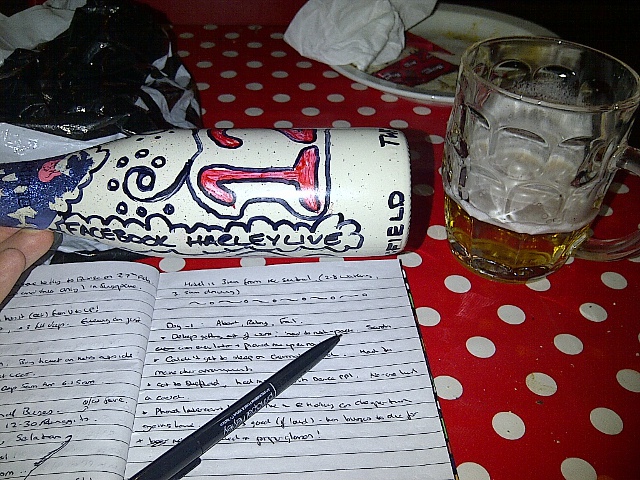
They even have fancy table order numbers!
Didn’t do much else for the rest of the evening, just chilled in the hotel room. Went to bed somewhere between midnight and 1am. Had a reasonably good sleep too – wasn’t disturbed by even the wild noises outside!
Had an easy journey to the airport – casual relaxed train. Oh wait, I went first class because it was cheaper (!) – due to the complex nature of the UK rail pricing system, it is possible, when you book ahead, for all the cheaper 2nd class tickets to be sold out before all the equivalent 1st class ones. This leads me to wonder what would happen if I needed to book a journey for *work* and this situation arose, as we’re only supposed to travel 2nd class (because it’s cheaper) … :p
Tried to sort out my Blackberry issue. Now, Manchester Airport a) has very little landward-side of note, and b) has no mobile phone shops. My terminal (and presumably the others too) however did have two electrical stores, so once I passed security I popped into one and got a new charger. Well, it worked in the shop …either that or they just wanted to scam me out of £34 …
Took an age to board – I was in the very last zone of the plane to be called. Lots of standing around (bored before I board!). Though the plane itself was *huuuuuge* – an A380 with what looked like an upper floor (there were stairs leading up to some mysterious fish-tank-looking-thing). The downside to this was the toilet I went into en-route was underneath some kind of roof so I could barely stand up in it!
Really good in-flight entertainment system. ICE (Information, Communication, Entertainment). The people at work might be amused to note that, while this system is very spectacular and pretty and far better than our ICE, it did still crash after about an hour, and they had to reboot it! Apart from that, I watched a film (shock!) – ‘The Wrong Box’, a very 1960s British Comedy. With Michael Caine, obviously. Most of the rest of the time I was listening to music (Mylene Farmer, even, and then all the no.1s of the UK pop chart, ever!).
It also had a CCTV system where you could watch what was going on outside. Very pretty leaving Manchester in the daylight, but a bit scary when landing at Dubai, especially when all you can see is a grainy image of the land below, you know most of what you’re not looking at is sea, and then the song that comes on my headphones is ‘Yellow Submarine’ by the Beatles. Meh. The other thing to note is the speed perception. Looking out the window looks faster than looking at the runway – presumably because the runway lights are more spaced out than road cats-eyes.
The second flight to Kuala Lumpur was on a smaller plane, but with the same system. I spent the entire time continuing my journey through no.1 hit singles. Then finished with Aphex Twin so I could doze. Not that I did much of that in fact – weirdly that in Dubai, although my body clock thought it was only about 10pm (ie, GMT), it *felt* like it was 2am (the actual time in Dubai). Arriving in Kuala Lumpur about 3pm meant that technically I’d spent 24 hours awake, and that Sunday wasn’t going to be a very long day. Still, a long sleep will work pretty effectively!
The transfers were all pretty easy too – easy to pay for and find the coach to the city centre (which may well have had a departure time but it very felt like ‘goes when full’. And I was the 7th person on a coach of about 45 seats … still, oooh, aircon!), easy to get the KL Metro the one stop to the nearest stop to the guesthouse, and easy to find the guesthouse!

Looks very homely!
Because I didn’t fancy doing anything too strenuous, I then had a wander through the huuuuge ‘Central Market’ that’s a couple of streets away – it’s mostly a two-storey indoor thing but there’s a street of stalls outside. Lots of stalls: bought myself a fruity drink (pink, that’s all I know!) from one, a collection of fruit from another, and sat down in the food court area to have ‘Lele Penyet’ – ‘Smashed’ fried catfish, with rice and … stuff. I chose the spicy option. Apparently it’s a genuine Indonesian dish. And Indonesia’s not very far away (just over the water, in fact).
Temperature today : about 30 degrees C, and it definitely feels it. It’s similar to how I felt in Hong Kong, but without the Chinese Restaurant smell. Mmmm, aircon…
Day 02: Monday 20 February –
Where the Sidewalk Ends
Kuala Lumpur. Like my friend John P, it is big and ugly. After all, no-one in their right mind puts a motorway through the centre of a large city! It’s also exceptionally humid, as two showers and several clothes will testify to. Also note that due to its preference for concrete flyovers and road bridges, and building works on the edge of roads, it’s quite a difficult city to walk around, as often there won’t necessarily be a route between two points that either doesn’t involve a large detour to avoid roads without pavements (including side roads that go under bridges), or crossing four lanes each way of rather busy traffic …
Due to being unable to draw cash out (and being unwilling to dip too much into my dollar allowance), but more because I was exceptionally tired having been awake for pretty much 32 hours straight, I decided not to get up early to visit Melaca (as I had been planning to do), but rather spend the day in KL instead, and see if it had anything to offer.
What it offered at first was rain. Not a thunderstorm, but a reasonably heavy downpour, British-style. This led to the dilemma – coat for dry and sweatiness, or no coat for wet and comfortness. I went for the latter. However, in fine noob-stakes, I didn’t realise the effect of rain on newly-applied suntan lotion. I spent much of the day with white streaks on my trousers caused where I’d lain my arms on them while sitting down.
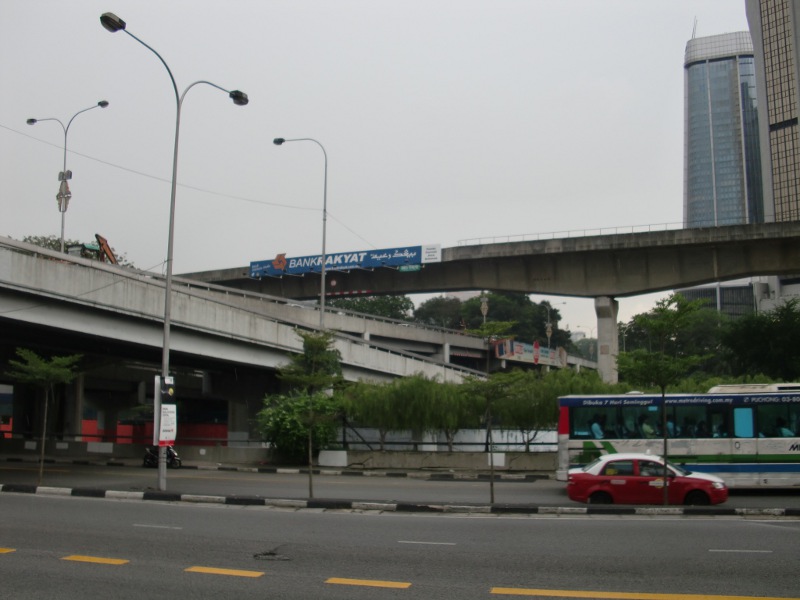
Concrete flyovers and skyscrapers. Sweat not pictured.
In the rain I walked past the old railway station (pretty architecture), and through the maze of roads to the West that lead up to the ‘National Monument’. This is partly a dedication to Malaysia, and partly a war memorial, well two in effect – the standard menhir-type, and then, surrounded by water, a sculpture of a series of soldiers in varying states of battle. Including dead. It’s quite high up so you get good views of KL from it. Or would if there weren’t so many trees in the way …
Some of these trees belong to the huge Lake Gardens, a myriad of pathways through a large botanical gardens and eventually hitting a rather large lake. Between there and the monument is also the National Planetarium (closed Mondays). By the time I’d reached the gardens the rain had pretty much eased off, which made walking through them very pleasant.
The final destination in the morning venture was the National Mosque, a rather large marbled building that’s open to tourists and visitors at certain times in the day – luckily I managed to catch them before they closed for lunchtime prayers. Obviously I couldn’t go in the actual prayer room but you can see it from “outside” and it’s pretty and large. Ended up chatting to one of the ‘guides’ there who I’m certain was trying to convert me to Islam!
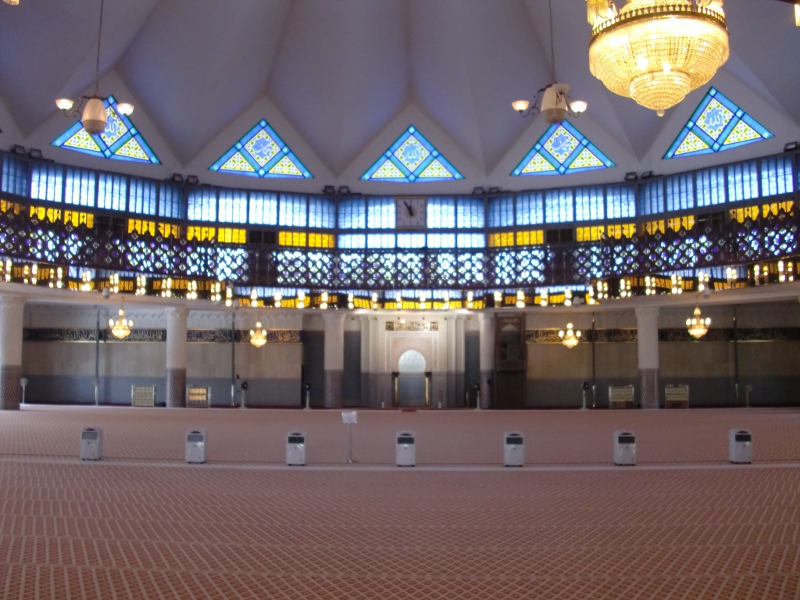
You can look but you can’t go inside.
Back to the hotel then for a quick shower and rest before setting off again. I am not Noel Coward. First destination was another indoor market stall place (Petaling Street) where one can buy all manner of tat. Tempted to change some money and buy a digital wristwatch for 35 Ringgit (there are 4.8 MYR to the Pound), but resisted. I *did* however buy a length of papaya for 1.20 MYR. I needed the fruitage!
Then had a wander up to Merdeka Square, a large area commemorating Independence in 1957. Much of it is grass. It used to be, in fact, a cricket pitch, and if you wander over it you’ll notice that the wicket is still covered! I was wondering earlier in the day quite whether Malaysia/Singapore had ever had a decent cricket team.
Had a slow wander back to the hotel for another rest (mmm, Aircon!), before heading out one final time, this time on a long walk over to the Eastern side of the city centre to explore the ‘Golden Triangle’ area. This was a bit more, uhm, “touristy”, complete with Starbucks (not yet Anne-Laure!), KFC, big hotels, and lots of people offering (legitimate!) massage services. [Where my guesthouse is is Chinatown / Little India. Lots of street stalls and markets. And backpackers. No tourists!]. This was during rush-hour so I merely crossed the road when the traffic wasn’t *moving* – which was quite often in fact. I walked all the way up to where the Petronas Towers are (closed Mondays, for the record, but I already knew that) – the trouble with them is that they’re just two large towers surrounded by other large towers so in a sense you don’t really notice them!
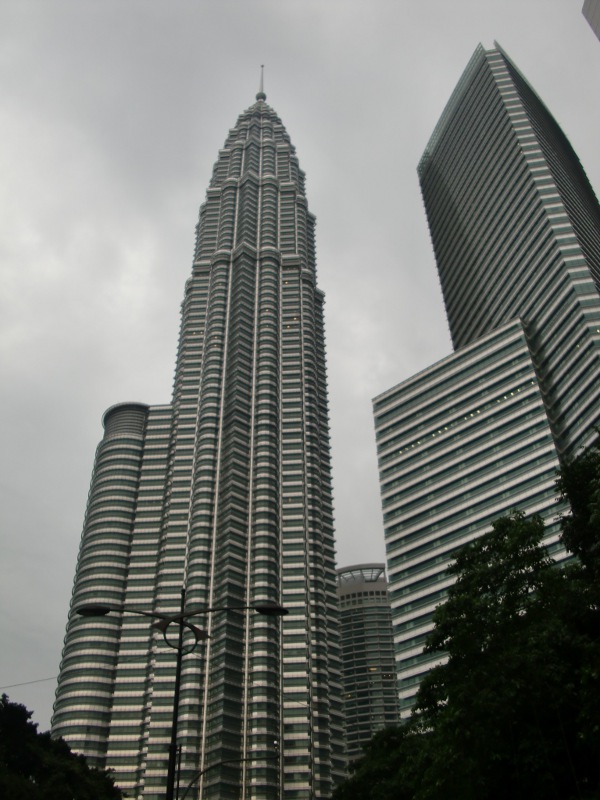
See what I mean?
Walked back, had another shower, grabbed some food at the Central Market again (Nasi Goreng with paprika, another Indonesian dish, quite spicy with ginger, chilli, and lemongrass. Jolly yumness!), before crashing at the hotel. Have an early start tomorrow – flight leaves at 7.35am so probably need to be up at 4.15am. Joy!
Day 03: Tuesday 21 February –
La Buddha Affaire
Things I have learned today :
1 – I worry too much.
2 – I am obsessed with time, for no long-term reason.
One of the most beautiful sights in the world (but not *the* most beautiful, which I would provide a link for but can’t actually *find* one, oddly!) is going through the countryside on a dark morning and find the way lit up by impressive lightning strikes in the distance. Doubly so when all around you is a cloudless sky …
Yeh, I made the coach. Worrying too much about catching it kept me awake all night. It happens to be often in fact, when I have to be up stupidly early – I end up not sleeping at all despite trying to. Mostly occurs the day before I need to do something important. Today was exacerbated by not having a guaranteed alarm clock, but in the event I needn’t have worried about that either. Went from bed to out the door in about 4 minutes, quickly caught a passing taxi (at 4am! Yay for city life!), and ended up on a coach to the airport terminal around 4.45am.
The specific ‘low-cost’ terminal was only notable for being exceptionally *busy* at 6am, for having its baggage drop-off areas behind a security area that only passengers could get to, and the unusual delight of ‘chicken curry doughnuts’ from a kiosk at the departure gate. I chose not to partake, and had a ‘kaya puff‘ instead. Because it was cheap and I’d never heard of one before.
Flight (AirAsia – one of SE Asia’s equivalents to Easyjet. Not Ryanair. AirAsia staff *smile*!) was uneventful. Arriving was also uneventful. $36 for visa-on-arrival; it would have been $35 but I didn’t have a spare passport-sized photograph. Which, as an aside, means it’s cheaper to get into Laos not having one and paying the excess than it is to get your photo taken in a Photomaton booth. Anyhoo. Vientiane airport is a very nice, simple, functional airport, it’s just very *quiet* – we were the only plane landing and one suspects that not many planes were due to take off or land there today.

First view of Vientiane, Laos. Coo, straight roads!
Caught taxi to hotel, arrived about 10am, but was allowed to check-in anyway. After overdosing on mosquito spray and sun-tan lotion making sure to leave a while before going out in the sun this time!), I headed out to see the city. My first stop was a Vietnamese noodle soup place a couple of blocks away, where I had … nope, don’t know. It had noodles in it. And broth. And veg. And … some other stuff. It *also* had a mountain of crushed chilli on the top; this was *my* doing and would come back to haunt me later. The lime wedges helped mitigate any searing pain in my lips at the time anyway …
After surviving breakfast, I walked through the streets, past a … well it’s called That Dam and is some kind of Buddhist reliquary. Although strictly speaking a communist country, Buddhism is very strongly linked with the style and attitude of the people here.
And Buddhas-a-plenty were where I was headed. Catching a local bus from the bus station (even though details are in the guidebook, this is something I just wouldn’t have done on my own even last year! Several touts tried to persuade me that, no, I wanted to go in comfort on a minivan, but I refused. 6,000 Kip and an hour of standing at the front of a very packed minibus later, I still feel I made the right decision), I went to the rather bizarre area known as Buddha Park – one man’s folly is another man’s tourist attraction. Evidently, he thought ‘what the hell’ and decided to create a park devoted to statues of the Buddha and related details (eg Naga). For reasons known only to himself. Quite odd.
Stayed there for a little while – not sure how long as I don’t have a timepiece. Travelling without knowing the time is both frustrating and strangely liberating! Had some food and looked out over the Mekong and onto Thailand. This is a very boring view, as it’s flat and there’s nothing much on the other side either, but it’s different! When I hailed the bus on the way back, I was the only person on it so I even got to sit down! Ah yes, bus travel in Laos is also a way to get things delivered (as on a couple of occasions, people on the bus either gave things to, or were given things from, people they knew on the roadside), and a way to shop for snacks (on the way back the bus was delayed cos people kept buying food from a roadside vendor). There was also a feeling from me at the same stop (serving the Thai-Lao border) that the bus wasn’t going to go anywhere until more people got on …
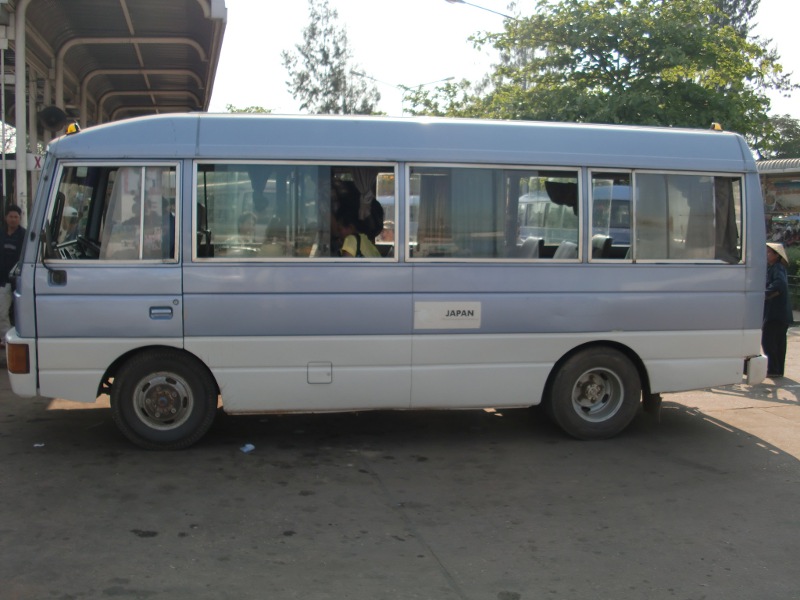
And this is the bus I took to get there. It was as comfortable as it looks …
Back in Vientiane, I wandered past one of the Wats, then took a tour of one of the more ‘depressive’ aspects of Laos life – a museum dedicated to unexploded bombs and prosthetic limbs. Basically, being the world’s most bombed country (an impressive achievement given that it wasn’t even at war at the time, or at least not with the party who bombed it! The USA were fighting in Vietnam and bombed the whole of Eastern Laos to try to stop the Viet Minh from supplying rebels in the South) means that there’s been an awful lot of death and injury sustained from things like cluster bombs. And it’s still going on (estimates are that 30% of such bombs don’t explode on impact, meaning much of the countryside is still dangerous!); this museum is part of COPE, who in part make plastic arms/legs for people who encounter such things. Quite sobering. Although the mango/strawberry ice-cream shake and the chat with the friendly (yes, yes, female) lady behind the ‘bar’ was relaxing.
Ambled back to the hotel. Started feeling rough (partly caused by the heat, mostly caused by the breakfast chillies), so had a rest before heading out for some food. Needed something soothing – found it in a Chinese restaurant (Chinese Green Tea works wonders, and the boiled rice should stodge and soak up any excess issues). Laos is an hour behind Malaysia, despite being further East, so it got dark a bit earlier than yesterday.
Day 04: Wednesday 22 February –
Who wants to be a Millionaire?
Ahhh good sleep. No rush to get up, took the view that if when I woke up it was daylight, then I might think about getting up. Then I lay in bed a bit longer! Got out the hotel somewhere between 8am and 9am, and headed into town. My plan for the day was to wander around the main sights of the city itself – a comfortable walking tour, in effect.
My first stop was actually a cafe, where a baguette with scrambled egg and a mango smoothie was consumed. There were a couple of small dogs sniffing around. As a side note, dogs seem to be quite popular pets in Vientiane, but none of them appear vicious (most of them just loll around in the shade). There is also a definite lack of dog-poo!
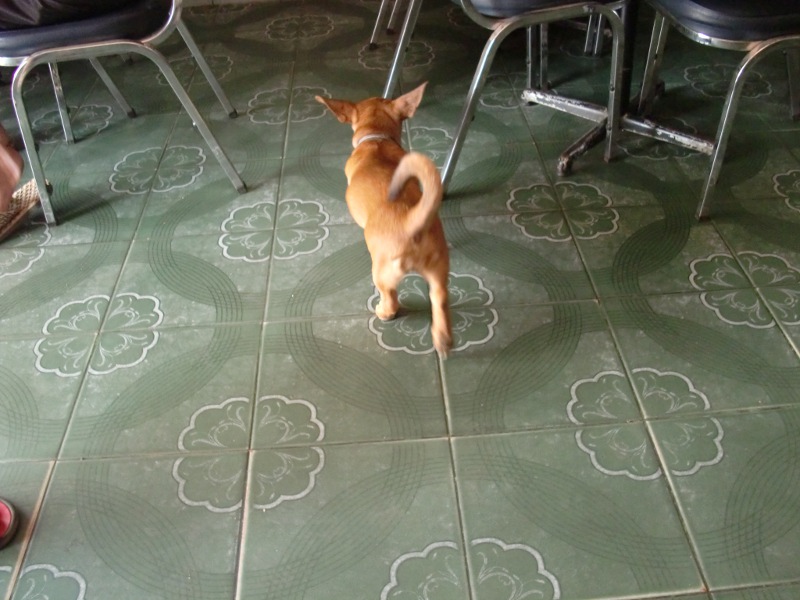
One of the dogs in the cafe. Wouldn’t stay still long enough for a front shot!
So. Headed down one of the main streets, past the main fountain (Nam Phu). Or would have done had it not been hidden behind construction walls. Evidently they’re refurbishing it and making it the centre-piece of a new bright place. So carried onwards to one of the bigger temples in the city – Wat Si Saket, believed to be the oldest surviving ‘wat’ in the city. This is, however, less impressive when you consider the Thais burned the entire city to the ground (except this temple) and evicted everyone when they crushed a revolt here in the 1820s …
As you might well expect from the name, the place is full of Buddhas. And Nagas, the Naga being a snake-like dragon-esque thing that’s highly prevalent in Indian and Indochinese mythology – often depicted as a Cobra but in Laos it’s believed they still live in the Mekong. (Hmmm, sea serpents?!) The temple is kind of divided into two segments – an outer ‘courtyard’ area surrounding an inner ‘sanctum’/’cloister’ area, The ‘courtyard’ is populated with quite ornate and colourful Buddhas, and what amount to ‘gravestones’ – decorated memorials with small pictures of people and dates when they lived (years). Around the outer walls of the sanctum are enclosed areas (colonnades) full of statues/sculptures – much plainer than those outside, but much more legion -, but also, along the walls, little mini-alcoves, each with even smaller statues therein. The best way to explain this is with a picture ..
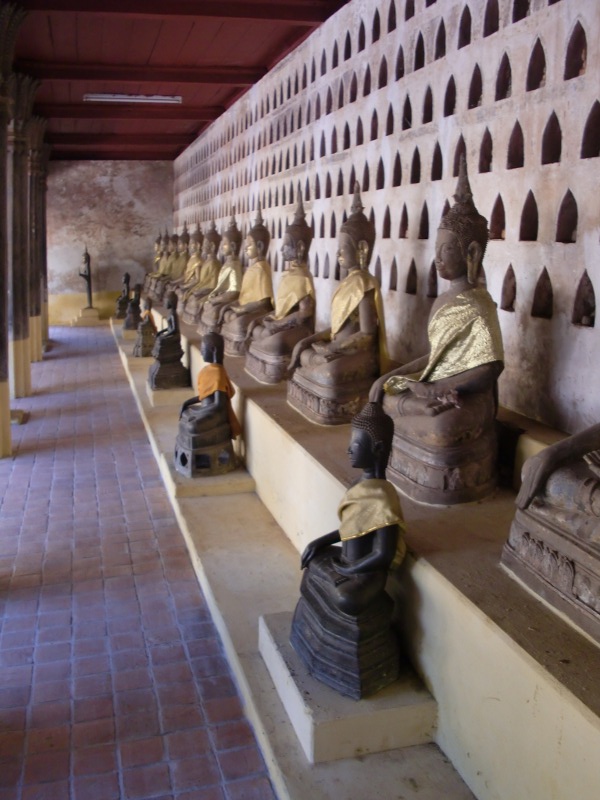
Buddha upon Buddha upon Buddha!
The very centre of the inner sanctum is the main focus of dedication, a small building wherein lies a huge Buddha, surrounded by flowers and decoration, with the walls painted with now fading murals depicting the Buddha’s life. But you’re not allowed to take photographs in there. So I didn’t.
On a similar vein, just down the road, is Haw Pha Kaeo, which is in effect a museum of religious art (which in practice makes it not much different to a ‘wat’, just without the monks – and indeed it used to be a small temple itself). The central focus here, up a flight of steps, is devoted to small museum pieces, whilst the landscaped ‘courtyard’ area outside contains quite a few statues, and, rather oddly, one stone jar.
Quite a walk then took me to Patuxai. Any relation this monument has to the Arc de Triomphe is purely .. yeh, the guidebook says that the name’s derivation is ‘patuu’ meaning ‘arch’ and ‘xai’ meaning victory. It stands in the middle of a roundabout, and the road ‘Th Lan Xiang’ runs in a perfectly straight line dual carriageway from the city centre to it. Apparently built from concrete supposedly bought from the USA to build a runway (this was the 1960s and Lao-US relations weren’t terribly good), it *itself* describes itself as a ‘monster of concrete’. Behind it is a garden area with a large lake, while inside (yep, you can climb to the very top) are at least two floors of marketeers selling clothing, souvenirs, and general tat. And I bought a hat. Because Sarah had said I should.
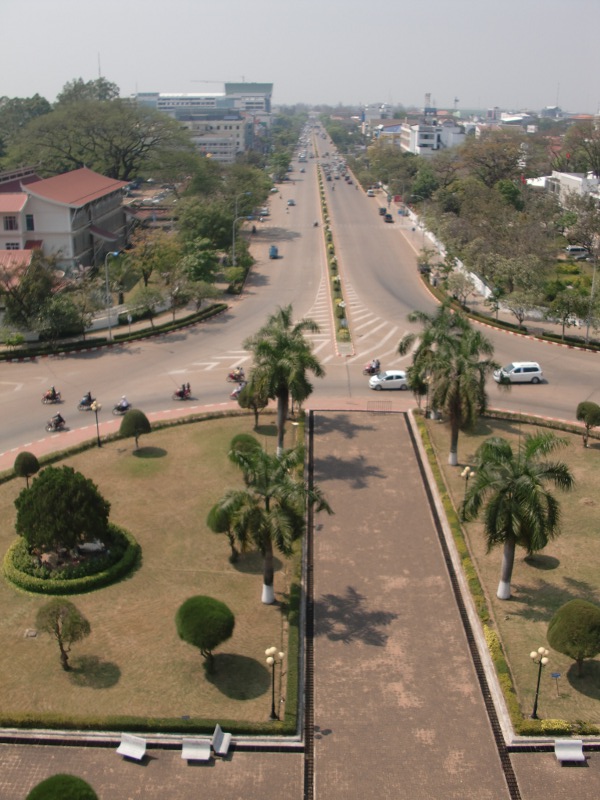
I love Paris in the springtime …
By now it was getting very hot, even with the hat, so after being chatted to by a couple of locals and me trying to explain ‘snow’ to them, I wandered off to find food. Eventually found a cheap place doing the fairly standard noodle soup type effect (Malaysian, oddly), but this time I purposely didn’t add any of either the crushed chillies nor the small raw chillies that were on offer at the table.
Stayed there for a while, enjoying the fan and the free water, before heading back to the hotel where I declined to go out again, and instead rested all day. Now I know why things start so early in Laos – because the midday sun is just *too* strong! Hmmm, siesta. Went out about 6pm to source more food (just after the hotel suffered a power-cut – hmm wonder how many p/kWh electricity is in Laos?!!) – ignored the pizza restaurant because, well, I don’t really care if it’s “the best Neapolitan Pizza you’ve ever tasted”, fact it, I’m in Laos and I can get pizza for the same price (71,000 Kip – £6!!) back home. Instead went for chicken rice from a street stall (13k), a dodgy sausage-balls-onna-stick (5k), and, to celebrate Pancake Day (yesterday but who’s counting?!), a chocolate paritha (pancake-like batter folded and cut into squares – 10K). On my walkabout I discovered the Night Market on the Mekong riverside with 100s of market stalls selling drawings, tat, etc, and kids skateboarding on the promenade. Very youthful. Got accosted by a gaggle of teenage girls (and a couple of boys) who insisted I posed with them for a picture. Shut up!
Oh yeh, I suppose I ought to explain the way this noodle/rice thing works. You buy a big bowl of what is effectively watery broth with noodles (or, alternatively, a simple plate of rice) and vegetables and stuff of your choice in (usually some kind of dead animal). Then, on the table already, are various condiments: not salty and pepper as you’d find in the UK, but rather soy sauce, fish sauce, fish paste, chilli sauce, crushed chillies, raw chillies, sugar, and, quite often, limes. You then add what you like, mix up, then eat with both chopsticks and a spoon, and attempt to whirl the noodles onto the spoon and eat with that. Most people are better at it than I.
The other thing to note about what I’m finding with regard to food in Laos is the preponderance of non-Lao places to eat. Having a phrasebook is all very well, but when you’re going to Chinese, Vietnamese, or Malaysian places, it’s not that much use … lol. There are also a myriad of backpacker/tourist places that do burgers and beer. These are quite popular … I am a little fearful of what I’ll find on that score tomorrow when I go to Luang Prabang, but at least I’m only passing through the backpacker hotspot of Vang Vieng – where the most popular activity is getting very drunk (or stoned) and then going ‘tubing’ on a rubber ring down the river. The Australian Embassy has issued a warning to tourists going to Laos to not do this because that appears to be the most common way tourists die in Laos!
On a happier note: money.
I went to an ATM in the centre of Vientiane, put my card in … and it said ‘transaction not complete’ (side note: disconcerting to see at the start of the transaction, when I put my PIN in, it said ‘Hello Mr Oliver / Ian’!). Tried it twice, failed twice. So, that means I was stuck with $190 to last me the rest of the holiday. While Laos and Cambodia aren’t terribly expensive places (there are 12,000 Kip to the £, which means my average meal is about £1.50), there is a limit and it would be terribly embarrassing to run out of money in what are amongst the cheapest countries in the world (relatively).
While walking to Pantuxai I passed a large, plush, air-conditioned branch of ‘Banque Franco-Lao’, and headed to it to change $50. However I got distracted by the cashpoint whose display was playing adverts (as ours do) saying that this was the first ‘European’ Bank in Laos. Hm, thought I’d try it to see what happened. It said ‘there’ll be a 30,000 Kip fee for this’. I said ‘OK’. It then gave me my requested 1,000,000 Kip. No mess, no fuss, just inconvertible currency. * shrug.
Day 05: Thursday 23 February –
A Curse on you, Leila Gaaliche!
So, before I went away, when I was planning the trip, I’d come to today and wondered what to do. The city of Luang Prabang was a new entry in my ‘places to go’ because so many people had recommended it (and it seemed more interesting than what I was planning on doing), but when I was arranging leaving it, the flight out South to Pakse on the Sunday was ‘unavailable’ so had to book Monday. This meant, for a town I wasn’t originally going to visit, I was now spending four nights there. This meant I now had choices about how to get *there* on the Thursday, as I wasn’t going to be rushed getting there:
* Fly. Cost : $55. Time Spent : 45mins. Quick, boring, functional.
* Bus. Cost : 110,000 Kip (about £10). Time Spent : 9-12hrs. Slow, scenic, lively.
I asked around. All but two people (my friends Anne-Laure and Leila) suggested flying; interestingly both are well-travelled people. Leila in particular – as she had actually done this very journey just under six years previously. A third (SmellyGreeboCat) said both had their merits but having been on a similar bus in Egypt she thought flying might suit me better.
Yeh. Well.
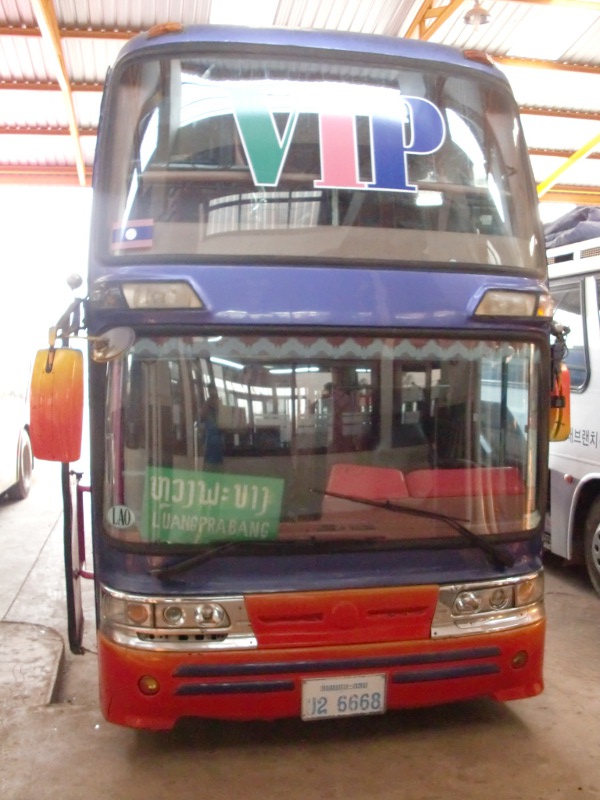
That’s the strangest looking aeroplane I’ve ever seen …
Partly driven by a wariness of money, partly by a feeling of ‘you only live once’, and partly because it might do me some self-good, I decided to go by bus. It’s about 380km. And on Western roads, it would be pretty simple (although on Western roads, also much more expensive). So I got up around 6am to get to the bus station in time to catch an early departure (they’re quite regular, but when it takes that long, I wanted to make sure I got there, if not in daylight, then not long after).
[Side note : the hotel had a second power-cut later in the evening as I was lying in bed; ironic cheers from a nearby bar suggested it covered a couple of blocks. This didn’t make lying in bed very comfortable as the fan was electric!]
Started the walk to the bus station, which on my map was a comfortable 3-4km. As expected, a couple of tuk-tuks came by; the first said the bus station had moved to about 7km away (a cunning trick to get more money out of me), and wanted 60,000 Kip, and wouldn’t bargain down. The second one, a little while later, said he’d do the journey for 30,000. This then rose to 40,000 when he went to the bus station and found that, er, it *had* in fact moved and was now about, er, 7km away … :p But still, 33% off the original fare …
Arriving at the bus station (very quiet), and looking at the list of bus times, I requested the normal 110,000 Kip fare for the trip at 7.30am. Despite the buses running roughly every hour, he said the next available ‘normal’ bus wasn’t until 11am. There *was* however a VIP bus at 8am I could catch, for 130,000 Kip. So I went for that instead.
The difference between the buses is quite vague, but basically the VIP bus has air-con and goes faster, the slower bus has windows that open, and stops more frequently. It’s also smaller seating space. Traditionally the VIP buses (they run on a few of the main routes) tend to be taken by backpackers (indeed most guesthouses and travel-agencies-cum-internet-cafes-cum-laundries offer to buy tickets on the VIP buses on your behalf, but not normally the normal buses), however my bus was mostly made up of Lao students, with a couple of old ladies and about 8-10 ‘foreigners’ (bus held maybe 40-50 people).
We left on time at 8am. On the way out of the bus station we very nearly hit another vehicle. But when you’re in a bus that huge, I’m not sure how much it matters!
The first maybe half the journey from Vientiane (until somewhere past Vang Vieng) was pretty uneventful, quite flat, and much on gravel road rather than tarmac, so it was a little bumpy in places. Quite weird to see the bus move either onto the other side of the road or well onto the roadside to avoid a pothole or other surface issue! We stopped off at a, effectively, roadside service station/market for about 20mins a couple of hours in, where people toileted and stocked up on snacks. Plenty of people around to buy from, either at stalls or just walking round the coach parking area.
An hour or so after Vang Vieng, the journey changed. While the road was now tarmacked (and would remain so for the rest of the trip), the landscape became more hilly and picturesque. This meant that our progress slowed right down, as the road went uphill and round some very sharp bends. Because I don’t have a timepiece, I don’t know quite how long we were going up for, but it must have been at least two hours, possibly even three – the bends were so sharp that we almost had to stop to get round some of them. In addition, there was no safety barrier so the more we rose, the longer the drop at the roadside. This only became apparent when we overtook a lorry just before a bend – on my side we looked very close to the lorry, but after we’d passed I looked to my left and saw the passengers going ‘my that was close’ as they looked at the drop on their side …
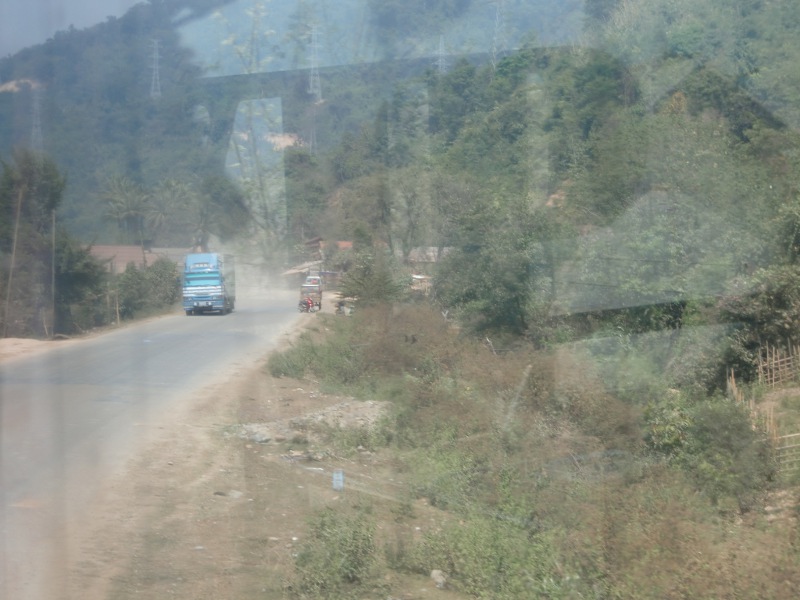
See how narrow the road is? Now imagine a wall of rock on the right and a sheer drop to the left. Nice, eh?!
Not long before our second food stop, we broke down. Well, *we* didn’t break down, rather the aircon stopped working. Since on the VIP buses you can’t open the windows, this means that if the aircon stops, it becomes unbearably hot after only a short while. Fortunately after about five minutes they got it working again.
A couple of hours later, the aircon stopped working again. This time it took maybe 15-20 minutes for them to fix it, and for a time we drove on with the engine cover open (it’s at the back). This is pretty much how it is over here, and no-one’s particularly mythered about how long things take – as intimated earlier there’s actually no fixed arrival time as it depends on so many factors.
To be honest though, one suspects that 8-9 hours is my limit for journeys like this – and certainly after it got dark I’d kind of lost interest. At least while it was daylight I could admire the scenery (which was indeed spectacular), and be quite casual about the fact that on some of the blind bends, we very nearly got hit by trucks passing the other way. Bear in mind that we were on one of the *first* buses of the day – that means that every other bus does much more of the journey in the dark. No streetlights, of course. And there’s even, would you believe, a designated *night* VIP bus that acts as a ‘sleeper’ service. It has beds. I’m not sure how you’d get much sleep on a road like that!
The journey in total lasted approximately 11 and a half hours, and we were a bit relieved when it was over. As per normal in Laos, the bus station is ‘some distance’ away from the city centre, but 8 of us foreigners grouped together into a tuk-tuk for the journey (15,000 Kip each). When you think about it, tuk-tuk drivers make a killing – the original driver in Vientiane wanted to charge me 50% of the price for the *entire* journey to Luang Prabang just to get to the bus station!
Got to the hotel, checked in, dumped my bags, and then immediately crossed the road for food. Never before has noodle soup and a chocolate crepe been so well received!
Day 06: Friday 24 February –
You put your left shoe on, your left shoe off …
(On, off, on, off, shake it all about. You give respect to Buddha then you turn around, that’s what it’s all about …)
Bea Marshall Quotient : 74%.
Luang Prabang is an interesting town. I’ve been trying to find the words to describe it all day – ‘sultry’, maybe. It’s certainly quiet (despite having lots of backpackers and lots of bars), reasonably relaxed, you rarely get approached by tuk-tuk drivers. ‘Lazy’ might be a better word. The best thing I could come up with, and some of the streets and feel of the place around the Mekong waterfront back this up, is:
if you imagine some pre-WW2 literature or setting for a film, where you have hot sun beating down on a tropical river, crickets chirruping, dogs laying lazily on the roadside, with colonialists in straw hats and jackets sipping gin and looking outside through a window with bamboo shutters and mosquito nets, with an archaic fan buzzing noisily overhead. That.
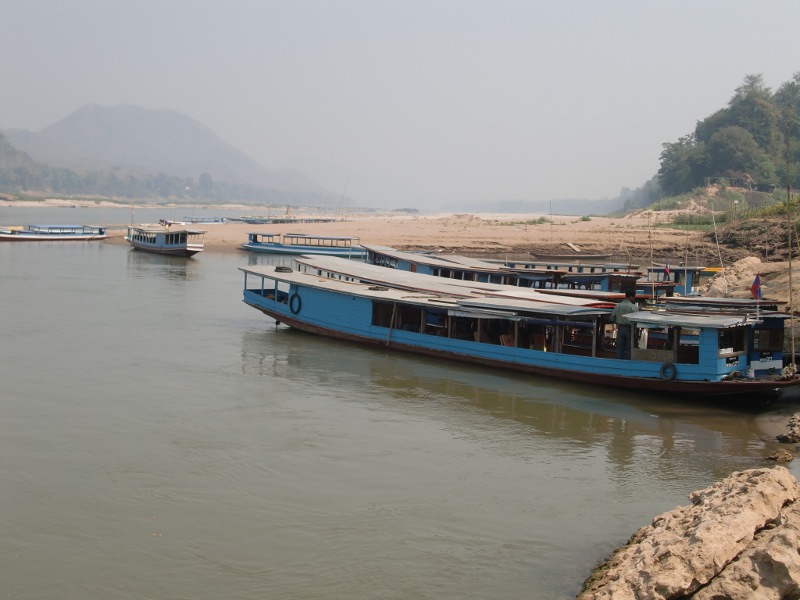
It is exactly how you’d imagine it to be.
Had a good sleep but probably not long enough. Breakfast was had at one of the many road-fronted stall-shops that line the streets round here (one thing to say about Laos, you’ll never go hungry! As long as you like noodles, that is. Or rice.), then wandered in the (slightly cooler) morning air. The guidebook says there are 329 steps to the top of Phu Si – the hill in the centre of the town (atop which is an inaccessible stupa) from which there are good views across the city. Or would be if it wasn’t quite so hazy. Both up and down (there are several stairwells) there are a number of wats, as well as a couple of oddities (like Buddha’s footprint – a depression in the rock that would have made him take approximately a size 50 shoe. And you wonder why he’s never depicted wearing any?! :p).
Wats (temples) actually took up a good proportion of my walking time today. Some of them were quite small (Wat Pa Huak consists of precisely one small hut containing a statue of Buddha), but others are pretty expansive (I got a bit lost in Wat Thammothayalan, on the way down from Phu Si looking for the Buddha Footprint). One of the differences between wats and churches, by the way, is that the wat is the whole complex – the actual ‘religious’ area (the ‘sim’, housing the wat’s main Buddha: the equivalent to, say, an altar inside a Christian church) is in one of the buildings in the centre of the wat. The rest of the wat is other ornate buildings/stupa/miscellanea. Although where a Wat consists of only a Sim (as per Wat Pa Huak), it’s still called a Wat!
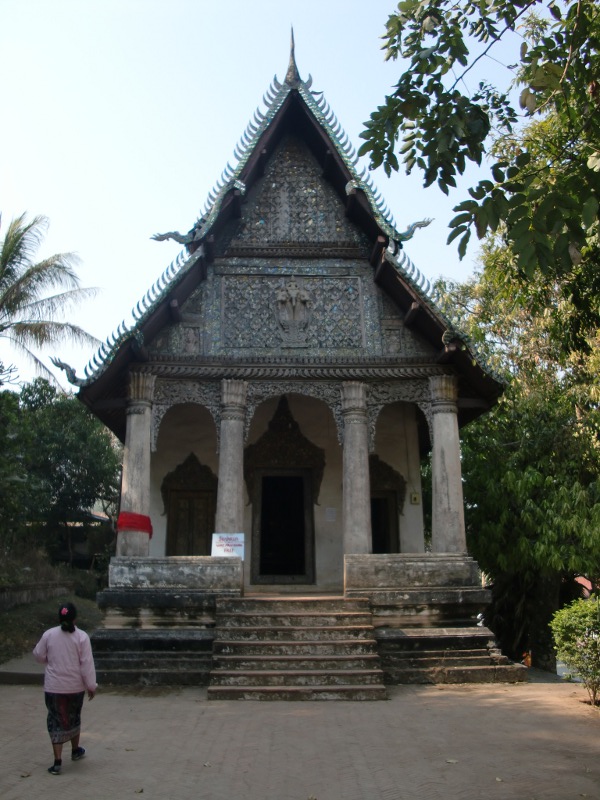
Wat Pa Huak. See, just one building. Still big enough for the Buddha!
Some wats also still function as monasteries, so will also include monks’ living quarters, etc. The biggest one of those I went to today was Wat Xieng Thong – which had several impressive-looking buildings of various sizes, as well as the Monk’s dining hall and quarters which weren’t quite so decorative! (The ‘sim’ here was being renovated so while we could go inside, it wasn’t terribly pretty!) And on my travels I saw quite a lot of monks; some were busy cleaning/sweeping leaves away in the wats, some were walking down the street to go shopping, and a couple were on motorbikes, yes.
After walking along the colonial-looking Mekong waterfront, I headed back to the hotel to stay out the midday sun (I was a bit late for that though! Though I did have lunch in the shade; a strawberry jam crepe and papaya fruit shake). I left again just before 2pm, although interestingly this actually felt the hottest part of the day. My next port of call was the Royal Palace Museum – the grounds of which include a huge Wat/sim with a very ornate … ‘carrying device’. Except that what gets lifted on this and carried around the town is no person, but rather a (surprisingly small) Buddha Statue – the ‘Pha Bang’ (from hence the town gets its name). The museum grounds also hosts the city’s theatre which holds traditional storytelling-in-dance a couple of nights a week.
The bulk of the grounds were dedicated to the monarchy. That is to say, the museum itself used to be the monarch’s house, and one of the outbuildings that presumably used to be a garage now hosts a few of the monarch’s cars (mainly donated by the Americans, and includes an Edsel!). “What Monarchy?”, I don’t hear you ask. In fact, Laos used to have three – there used to be three Kingdoms; Luang Prabang, Vientiane, and Champasak. It then got ‘a bit complicated’ when the French colonized and partitioned the country in the late 19th century – Luang Prabang was made into a protectorate, the rest governed directly from Hanoi. It then got even *more* complicated when the French left after the Battle of Dien Bien Phu; Laos was nearly split (like Vietnam) into Communist and non-Communist areas, and one of the members of one of the other ex-ruling dynasties seems to have thrown his lot in with the Communists. Then things got more complicated … the US got involved, Laos became the most bombed country in the world, and, unsurprisingly, the communists won (not by fighting, incidentally, but by supporting whichever government faction was in power at the time, including the royalists), but eventually they overthrew the monarchy in Luang Prabang and turned their house into a museum.
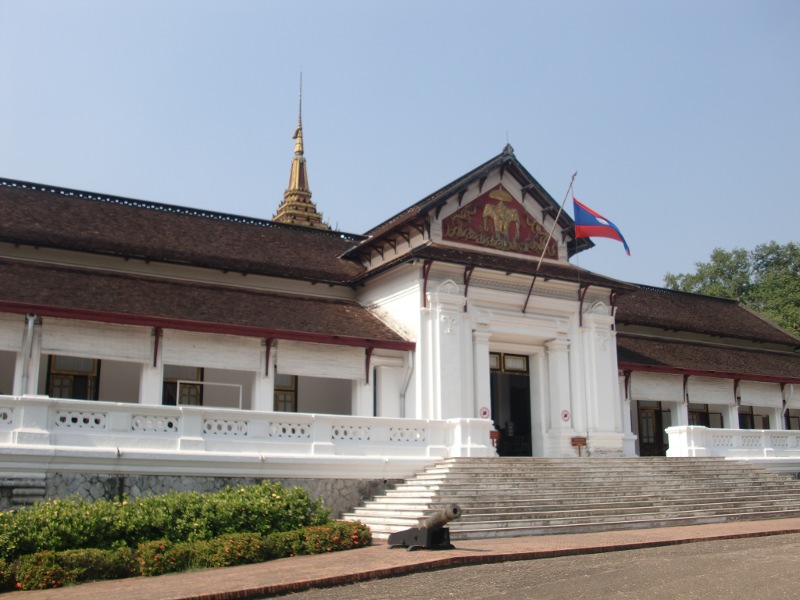
The Royal Palace Museum. This is as much as I can show you!
I can’t show you any pictures of inside the museum itself though. Not only are photographs not allowed inside, but you literally can’t take *anything* in. There’s a room to the side where you place your bags etc into a lockable locker, then take the key with you as you walk around. Things banned include : hats, bags, cameras, mobile phones, and shoes. Yes, you did read that right. It’s actually quite an interesting browse through, with portraits of the last few kings and queens, utensils they used, things given to them by foreign dignitaries (like samples of moon rock), all contained within the rooms that presumably looked how they were – even the large bed had a mosquito net on it! Pretty sizeable – each room was huge in and of itself.
From there I had a wander through some of the small side-streets of the town, past a few more small wats (obviously!), and had a browse around the outside of the French Cultural Centre which had a series of information boards about two French people who’d done a year-and-a-half trip by car from France to Laos, passing through 18 countries and explored issues about water use and conservation in each of them. Commendable!
Back to the hotel for a bit, then headed off down the waterfront of the Nam Khan river where there are lots of restaurants. Found a place that sold reasonably cheap ‘aw lam’ – a kind of soupy-stew of ‘stuff’, but which contains *wood chips* as flavourings! Not sure what kind of wood it is – oddly when I accidentally bit into one the taste seemed familiar though! Was there for quite a while – partly because restaurants in Laos take their time over service (especially the bill!), but also because when you know this, you don’t actually mind, and it’s such a nice setting, even in the dark.
Day 07: Saturday 25 February –
The Falang is Funny and has no Balance
Rolled out of the guesthouse around 9am, which is about an hour later than I’d planned. That said, I knew today would be a reasonably relaxed and quiet day. Sort of.
Had a wander on the roads away from the town centre at first – although I already knew that the UXO Information Centre (more bombs!) was closed at weekends, there were a couple of other little things in that general direction that I wanted to pop by. First though came breakfast – at another one of those roadside shacks. Chicken Fried Rice (£1), which while it might seem to us an odd breakfast, remember over here rice or noodles are *the* staple foodstuff – the same way we might eat bready items. Meal served with cold green tea, quite refreshing.
The morning wasn’t as hot as previous days, which was a relief, but still “warm”, so the walk was comfortable, at least this early. Next stop was the Statue of the ‘Red Prince’ – a monument to celebrate 100 years since the birth of President Souphanouvong, first president of Lao PDR. Now, remember yesterday I mentioned the role of the monarchy was ‘complicated’? Well, he was not only the figurehead leader of the communist insurgency, but also the half-brother to the reigning King! Hence the epithet ‘Red Prince’. His statue stands in quite a nice landscaped garden area, but just in the middle of nowhere, really.
Obviously my walk then took me past another Wat (Wat Manorom), where again a couple of the buildings were adorned with murals. On the outside of the sim this time however were a couple of long panels of ‘mural’ that were actually ‘sculpted’ rather than drawn.
The quiet backstreets took me past a large group of men playing several games of petanque (remember, Laos was French, once!), and then back to the main road along the Mekong. Walking away from the city centre a short way, towards the monument dedicated to Kaysone Phomvihane, the first Prime Minister and de facto head of Lao PDR during the aforementioned Souphanouvong’s presidency, I came upon what I presume to be another communist memorial (it had a Red Star on the top of it) – although unenscripted and located in an overgrown field behind gates that were held shut by a large stone. Obviously I went in and had a nose at it!
I turned back on myself and walked up the road along the Mekong. This is one of the many main routes in Luang Prabang, and is full of guesthouses and food stands. But obviously not as cheesy as Blackpool. Eventually I reached the, I guess if you were being kind you’d call it the ‘ferry terminal’. My aim was to cross the river to the small settlement of Ban Xieng Maen; at the top of the stairwell down to the ‘departure point’ there are lots of people touting for boat business, but they didn’t seem able to comprehend that I was happy to just get in the boat with the locals. They wanted to charge me 60,000 Kip to charter a boat so I could float off as I pleased. I figured paying 5,000 Kip (one way) to get in a boat with a load of locals was a much better deal.
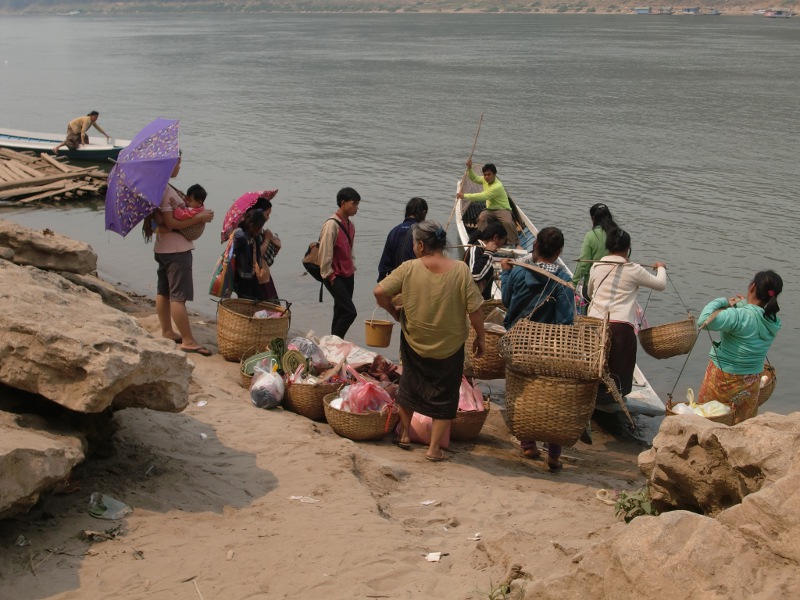
It’s not quite The Pier Head or Dover, is it?!
Boats sail regularly across the river, and the trip only takes maybe two minutes. The fun bit is getting on and off them, especially for someone like me who doesn’t have much in the way of balance! So it was a bit weird when I got on – especially as there wasn’t much room so had to turn round and sit on the floor – doing so made me collide with a load of empty water bottles that one of the other passengers was transporting. Cue embarrassment!
Got to the other side, and walked up a steep sandhill into the centre of the village – two roads almost entirely consisting of market stalls and food stalls. I took the right fork, and after not very long at all it turned into a paved, single-track road with houses either side, again some of which served as makeshift cafes. I passed one small Wat, several sleeping dogs, and kept pace with a truck full of stones/bricks with a three or four kids in the back hitching a ride.
The road eventually petered out, first into a stone track, and then into more-or-less a footpath. At this point there were a flight of steps leading up to another Wat (Wat Chomphet). Some wats you have to pay to enter (for upkeep, mainly), but it’s usually some (relative) derisory sum like 5,000 Kip; this one had an adult and two kids looking after the ticket stall who made passing comment as to my hat (or, in fact, “where did you get that hat?”!!, and having a discussion that it was Vietnamese in style). The climb (about 120 steps) was quite tough in the now late morning sun, but the Wat at the top was actually pretty nice. And cooling! The views out over the river(s) and over Luang Prabang town were good, but again it was still quite hazy. It tends to be this time of year, apparently.
I went down and wandered a bit further, to another Wat (Wat Longkhun), which apparently has another royal symbolic connection – would-be Kings traditionally came here for a couple of days before they were due to be crowned. Today, however, the place seemed completely deserted. The long wooden walkway in however reminded me of some kind of entry to a dark place in a video-game.
There were more things further down the path but they were a bit far and by now it was very hot, so I headed back. Before getting the boat back to Luang Prabang, I stopped off at one of the market stalls to buy food. 5,000 Kip got me some dodgy meat on a stick (that tasted faintly of innards), and 2,000 kip got me three aliens on a stick that were mostly cartilage.
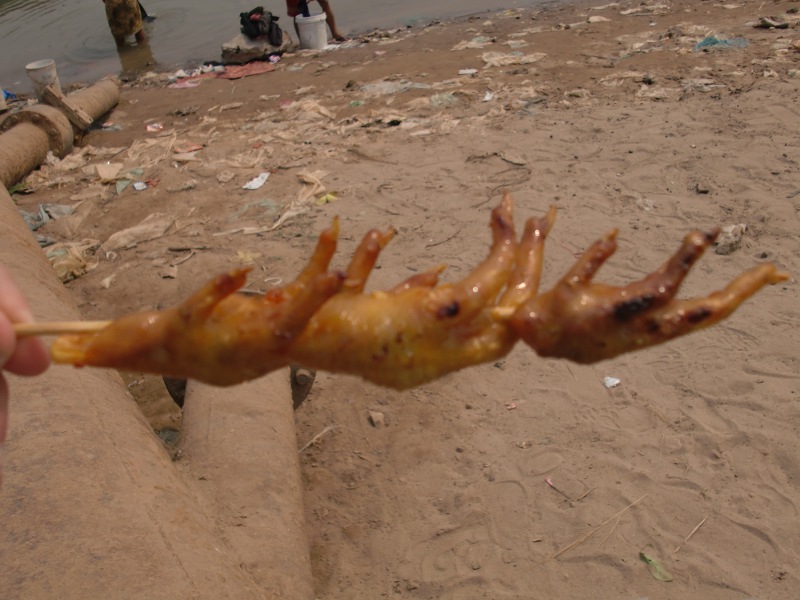
I assume it was some kind of squid, but who knows …
Ah yes, the boat back. Much emptier this time (and I had to wait longer to catch one), so I even got a seat. *Getting* to the seat was quite interesting – my lack of balance ensured that I rocked the boat at least twice and nearly fell over once. Cue much amusement from the locals. Meh! Speedy journey though, so it wasn’t long till I was back on dry land and heading back to the hotel for early afternoon sun avoidance.
I left the hotel again around 4pm, but it was still pretty hot. I again headed South (as I did this morning) but this time then turned left and crossed the Old Bridge – a bridge across the Nam Khan river that’s only accessible by pedestrians, bicycles, and motorbikes (but almost exclusively the latter it appears. As a side note, not only are motorbikes incredibly common here, but I’m not sure what the legal age to ride one on your own is. I only comment because I’m sure I’ve seen some ridden by like 13-14 year olds! Or maybe people are just looking older at an earlier age.). Presumably this restriction on bridge passage is because its structurally unsound. The fact that a couple of the wooden beams creaked and moved when I was walking across it suggests that. Possibly one of the scariest experiences of my life. It’s not a very long bridge, but …
There’s not much on the far side of the Nam Khan but it’s quite pleasant. There’s another Wat (Wat Punluang) and a well-regarded restaurant with cushion recliners rather than seats, but the menu wasn’t terribly interesting (a small selection of generic Chinese dishes) so I didn’t eat there. Instead I walked down the stairwell to the riverfront to cross on the Bamboo Bridge I photographed yesterday. These bamboo bridges are only built in the dry season, as it’s only then that the water level is low enough to be bridged. It’s another interesting bridge, as it ‘bounces’ as you walk, and the gaps in the bamboo are wide enough to be visible. It’s a bit like walking on a netted trampoline.
Had some food at one of the riverside restaurants I passed yesterday. I’m using up my money so fast because I’m spending so much on decent restaurants for evening food! Today was expensive – 60,000 Kip (£5). I must keep my spending in check.
Day 08: Sunday 26 February –
Cultural Awareness and Diversity
Today didn’t go initially as originally planned. Don’t worry, that’s not a bad thing! Simply that I’d got this idea to take one of the daily tours – a half day trip along the Mekong to a cave and a local village. Except it left at 8am and I woke up at 8.15am. 😀 No biggie – just had to find other things to do.
The morning was spent casually wandering around the city again for a couple of hours, going down the minor backstreets and seeing what the tourists tend not to. Which, to be honest, is not very much! Breakfast was another bowl of noodle broth at a sidestreet stall.
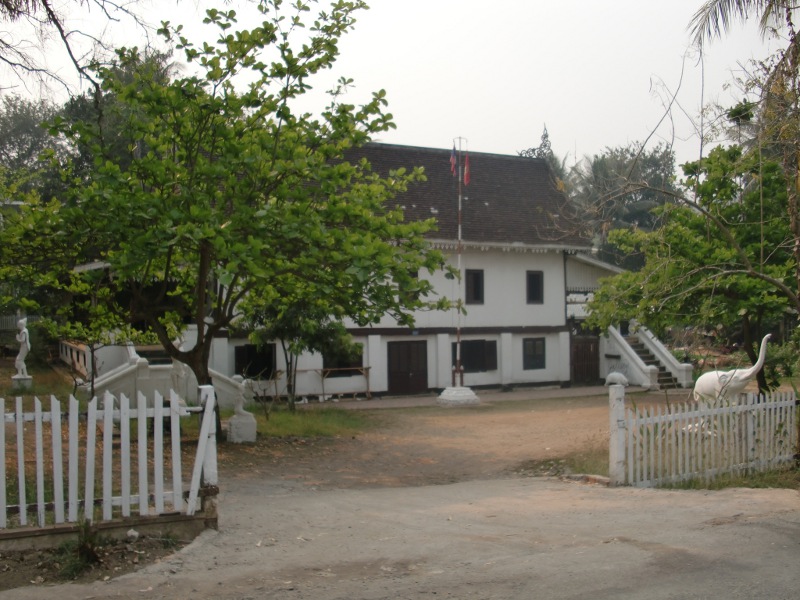
A nice colonial building in a side-street, complete with, er, elephant.
Oki, quick education time again:
Laos is a big country. Contained within that country are somewhere between 40 and 150 different ethnic tribes/groups/clans, depending on how you define ‘different’ and at what level you look at. Each have different origins, beliefs, lifestyles, food, culture, language, etc., and each live in different parts of the country – some are ‘uplanders’ and live on the sides of the mountains in the North, whilst others live in the Mekong Valley towards the South, and so on. Examples of different groups are the Alak, the Hmong, the Khmu, and the Tai-Lao (the latter group being the majority of the Lao population – about 68%). Which, again, makes the use of a Lao Phrasebook somewhat pointless … meh.
With that in mind … one of the museums near my guesthouse is dedicated to the ethnic diversity of Laos – TAEC (Traditional Arts & Ethnology Centre). It consists of four areas; two of them are the museum, where part of it is devoted to the different styles of dress and household items found in traditional villages, while the other part is about how the different tribes handle courtship and wedding rituals. There’s also the obligatory museum shop, but also a restaurant/cafe which serves traditional ethnic food.
It was pretty interesting to see the diversity; some tribes display affluence by sewing Indochinese coins onto their clothing (mainly women who do this). Some tribes excel in weaving – and indeed women use weaving as a way to show how good they’d make as wives. With regard to courtship, many tribes are exogamous (ie you have to marry outside your clan), and while marriages aren’t *arranged*, parental acceptance is very important. There’s also the dowry-price which the groom’s parents have to find, to give to the bride’s family – sort of as a ‘thank you’ to them for raising her! One of the ‘case studies’ displayed was of a chap who, partway through the courtship ritual, won the national lottery. His offer of dowry-price? Two bars of gold … !!! [it worked, funnily enough!].
After going back to the guesthouse to avoid the midday sun, and having a bit of a rest, I felt I needed lunch. It being Sunday, the street-stall-cafe over the road where I’d gone on Thursday was closed. I had a hankering for a crepe and scoured the streets to find one but they’d all left! There were still plenty of stalls – mostly selling the usual noodle soup and fruit shakes though. I decided to have a proper ‘meal’ instead (as I’d planned to go to the night market food stalls for the evening), and in fact went back to TAEC for some chicken pate stuff and sticky rice. Now, sticky rice does exactly what it says on the ‘tin’ – it’s sticky. It’s served in a cylindrical bamboo rice holder, and you eat it with your fingers – you pull some out, roll it into a ball, and generally dip it in the food or use it as a scoop. Obviously it works better with dips or meals with thick sauces than it does for noodle soup … but works brilliantly with something like pate!
After another little rest at the hotel, I headed off for the long walk to the OckPopTok centre. This is actually a place where you can learn to do things like traditional silk weaving, bamboo weaving, or dyeing (all on half-day, full-day, or several-day courses), but you can just have a look around as well. It was pretty interesting too – I’d be no good at that sort of thing as I’m not very good with all things manual. I saw the whole process, from farming the silk from silkworms, through dyeing the silk, to several different ways of weaving it (one of which looked horrendously complex, where a small cloth could take up to a month!). The dyeing too was interesting – using about 8 or 9 different raw materials (including things like rosewood, turmeric, and lemongrass), you can create pretty much any colour you like. The most popular/common are the several colours made from the Indigo plant – indeed many of the costumes I’d seen at TAEC were of a blue-ish pigment.
The venue was in a really nice setting overlooking the Mekong, but quite a way out of the city centre – you’d have to be specifically looking for it to be going there. There’s a cafe on site too that sells drinks, one of which is Silk Worm Poo Tea. Yep, tea made from the excrement of silkworms. It’s a rich dark-brown transparent colour (like a decent ruby beer), and tastes slightly roasted. The person who took me on the tour also kept feeding me this unusual fruit contained in a bark-like pod – the fruit’s made up of segments and within each segment is a big seed. It’s a bit like eating a caterpillar and it tastes weirdly like tomato soup. He called it something like ‘Tummalin’ or ‘Tummerlin’ – I’ve since found out, thanks to my friend Nitsa in Canada, it’s actually Tamarind (a substance I’ve never actually *seen*, although tasted it before because it’s in brown sauce!), which makes sense as it’s also one of the dyes they use.
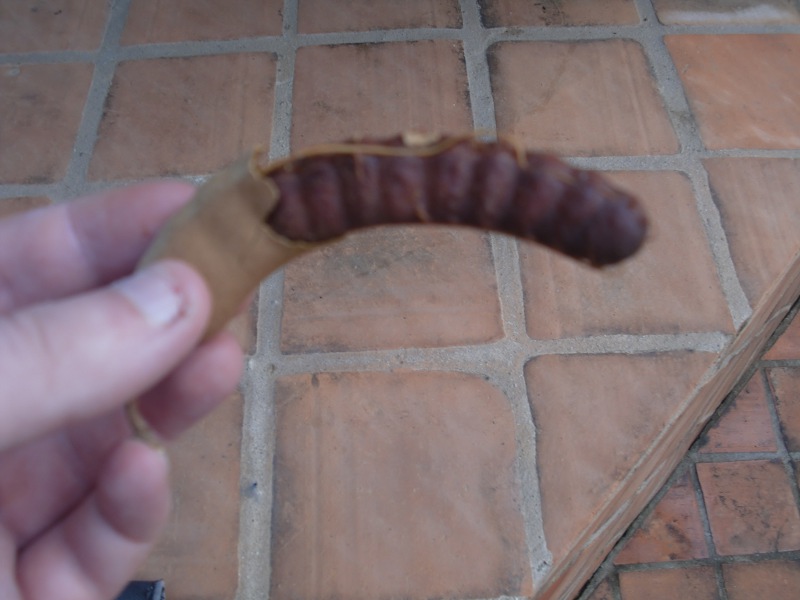
The fruit in question. Looks like … something else entirely, in fact!
Once I left there, I took a long but casual walk back to the city centre. It was still daylight but it had cooled quite a bit, which was nice. I ended up at the night market, which had already started to set up – the main street was closed off and stalls were set up *in* the street as well as to the side. Quite crowded! I had some food at one of the many ‘all-you-can-eat-on-one-plate-for-10,000 Kip’ stalls, which is pretty good value for Luang Prabang – am annoyed I only discovered this on the last day! Ended up chatting to a Dane and an Austrian who’d come from the North of Laos and were 3 weeks into a 2-month holiday. Gosh!
Ooo, I must also mention the toilet in the guesthouse. While it has toilet paper, it is situated under the sink rather than by the toilet. Rather, it has a small shower-type nozzle … it’s a very powerful jet-spray that feels not a little how I’d imagine an enema would feel. Effective though, but only once you’ve got the hang of using it!
Day 09: Monday 27 February –
Wat the Phu?
Got up reasonably early in fact, giving myself plenty of time – I had a flight to catch but it wasn’t due to leave until 10.55am, so I thought I’d try to get to the airport by about 9am. And I managed it, despite purposely going the long way round, *and* paying 5,000 Kip to cross the bamboo bridge, because I just couldn’t face crossing on the ‘Old Bridge’ again! Not with a heavy rucksack anyway! Regardless, it might well be the first time I’ve ever *walked* to an airport in order to catch a flight.
Luang Prabang International Airport is small, and it looks like they’re still building a runway as there are building works all along the road leading up to it. The other notable thing was the number of Westerners on the flight. I’d tried to get a ticket for yesterday’s flight, but they were unavailable, and I’d jokingly said to Sarah – ‘maybe it’s full of lazy backpackers who want to go to Siem Reap (for Angkor Wat)’ – the flight goes there but uses Pakse in southern Laos as a stopping-point. And sure enough, when we arrived at Pakse, most of the passengers *didn’t* disembark … !!
The flight was uneventful, if a bit bumpy at times; although I was by the window, I couldn’t get many pictures as the air was still pretty hazy. The in-flight snack was notably unremarkable – a small round cob with something grey on it that may have once been chicken, three pieces of fruit, and a small slice of sponge cake with green stuff in the middle. Still, apart from a tamarind thing, it was the first thing I’d had to eat! Pakse airport is even smaller; one runway. We landed and sped past the terminal building, then did a U-turn *on* the runway to go back to it. *That* small!
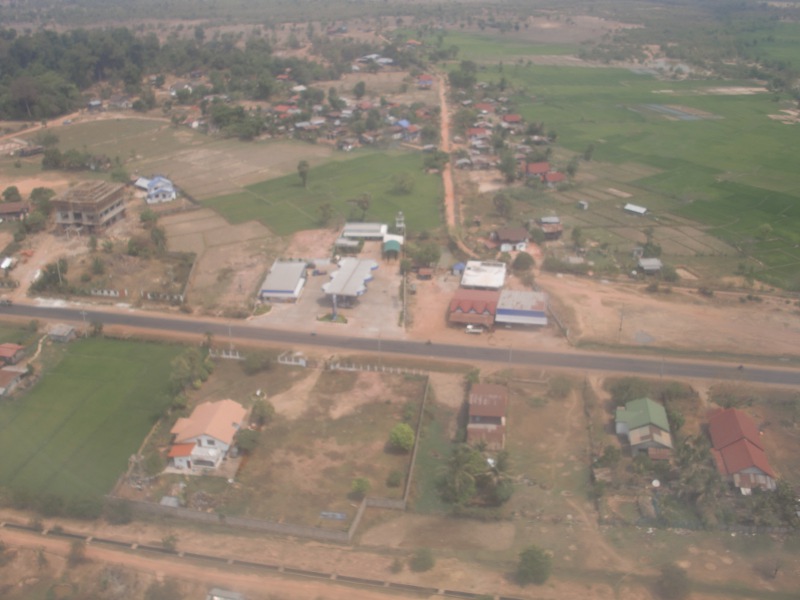
Coming in to land at Pakse Airport.
At Pakse, I fortunately managed to come across an older married couple who were also headed for Champasak, so we shared a minivan together. Champasak’s a small town about 30km south of Pakse, but is famous for being the nearest location to Wat Phu Champasak, a large expanse of ruins of an ancient Khmer city (we’re talking 1,500 years ago). Champasak is *also* famous for being the third seat of royalty (Vientiane and Luang Prabang being the others) when Laos had three kingdoms. One might almost say I’ve done a full royal tour of Laos :p The journey there was quite speedy, along a newly-built road with two toll-booths, which were staffed by what I have to say looked like archetypal wild-west-era Mexican Bandits (the whole area gets quite dusty so the look is practical, if coincidental)!
Had small issues checking into my hotel – the most relaxed man you’ll ever see staffing the least hotel-looking building you’ll ever see wasn’t sure what to make of me; he called his supervisor who I ended up having to talk to on the phone. Twice, because his idea of ‘hold the line’ was to hang up. He still never confirmed he’d got my booking, but I think by the end of the second call he knew where to look. The chap on the reception desk didn’t really care, and showed me to a room anyway – a downstairs room looking out onto the grass behind and thence the Mekong. Or *would* look out if the windows didn’t have a gigantic mosquito mesh on them. 😀
He then wondered if I wanted to go to Wat Phu. I had been wondering if it were better to do it this afternoon or tomorrow morning as I wasn’t sure how long it would take to look around, but I agreed. He said a man with tuk-tuk would be along in about 5 minutes. Now, in Lao Please Don’t Rush, 5 minutes is an awfully long time. But then it wasn’t as if I was in a rush either – there wasn’t anything else I was going to be doing! But eventually he came, and we were off.
An interesting journey – tuk-tuks don’t have the greatest suspension in the world (look, they’re simply vans with the back cut off and benches screwed along the sides!), and the road there was still being built (we passed through a whole section where they were literally building it), so it was mostly bumpy and dusty. After arriving, we arranged for him to wait there while I went in and looked around – about an hour and a half we reckoned.
First was the museum, where they had quite a few exhibits that they’d moved in from outside, and others that had been taken from similar, much smaller, sites around. The mythology here is very similar to Hinduism, and statues of Vishna were reasonably common, as well as the Naga, of course. They also, er, had a passion for ‘linga’. Linga are, in full, column-like with a rounded end. However usually just the rounded end is carved (often five together in the pattern like that on a die). Sometimes they’ll even carve a face on them. Since ‘linga’ is Sanskrit for ‘penis’, that means a) as with most mythologies there’s a certain amount of smut, and b) the ones with the carved faces must therefore be ‘dickheads’?! :p
[As a side note, the site is built into a mountainside – Phu Pasak. However the mountain is colloquially known as Phu Khuai, or Mount Penis. Now I have to say it didn’t look much like a penis to me, but it does suggest that the people of Southern Laos like to push the point home a little …]
The site itself is in very picturesque surroundings, and starts with the lower layer of a couple of very large reservoirs (Barays) that were formally used to provide water to the city site. These are very long indeed – to the extent I even wondered if I was walking in the right direction (what didn’t help was the incredible heat and the fact nowhere seemed to sell or provide water, ironically!). At the other side of the Barays there was a defined ’causeway’, laid out by pillars, that originally ran between two other Barays that are now dry.
The middle section of the site, up a steep and uneven flight of stone stairs, sees the pathway go between the remains of two rectangular pavilions that are still being worked on so you can’t go that close to them, which is a shame because from a distance they looked pretty hefty!
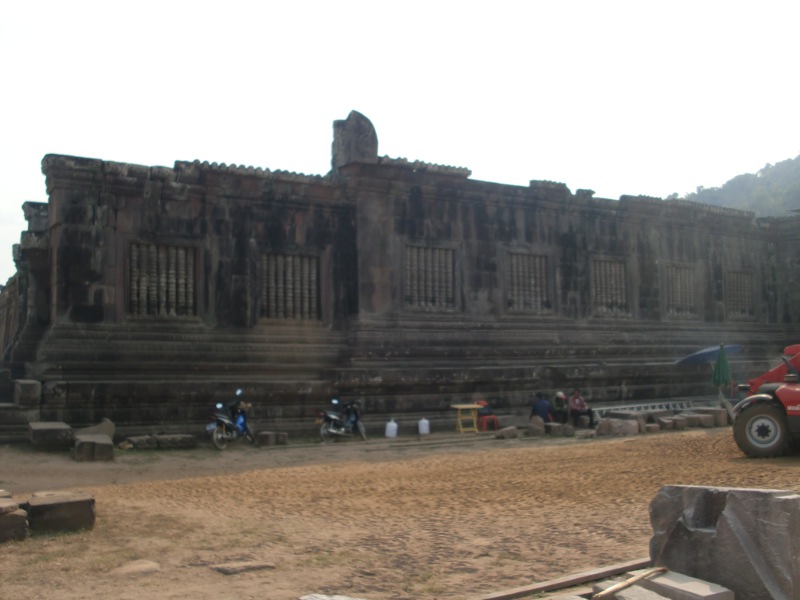
Must have looked quite impressive when it was completed.
The top level consists mostly of trees and Buddhist shrines (some in unusual places – like in a gap below a cliff face) – the original Hindu shrines and effects being long gone. There are also some more ‘unusual’ features, such as the Elephant Stone (not a Stone Roses song, but a stone with a carving of an elephant in it – but this is more recent, only about 500 years old or so), and, wouldn’t you know it, a Buddha footprint!
As a site, I have to say it was a bit underwhelming. Oh don’t get me wrong, it’s very pretty and quite amazing to see, but I couldn’t help but feel ‘is that all?’ when I’d seen it all. The views from the top are pretty stunning, looking out over the plain, but the site itself, yeh … Still, I’m glad I went!
The journey back was uneventful; had a shower at the hotel (stifling heat! I don’t know what the temperature *was* but mid-30s I’d have said, at least!), then walked down the main (only!) street of the town. It actually felt like a small English country village on a Sunday – there didn’t seem to be anything going on, and no-one was really about. There were a couple of restaurants open but even the staff didn’t seem to be around. I eventually had something to eat in a restaurant attached to another guesthouse, and I only went there because I saw *people* sitting outside it! It took a while to get served (because, well, no rush! And that’s from me as well not pushing it!), and by the time I left, it was dark. The only people around were the ubiquitous motorbikes that seem to be everywhere but don’t seem to be going anywhere in particular.
No Internet access, so an early night. Still haven’t decided what I’m doing tomorrow, or even worked out which country I’ll be in. It might depend what time I get up – but even with the fan roaring above me, it’s still too hot to sleep yet (it’s 8pm as I type this).
Day 10: Tuesday 28 February –
One Night Day in Bangkok Sisaket
As a side note, in all the time I was in Laos, I never once had a BeerLao. I had a sip of ‘lao lao’ whisky – the Danish/Austrian couple I met in Luang Prabang night market let me have a sip of stuff they’d been given when they were in the far North. Went down like Brandy. Was probably rocket fuel. Sounded vaguely familiar …
In a very hot room with just a ceiling fan circling, and no Internet, I went to bed relatively early, with only Jane Austen to keep me company (hey, if I’m going to read chick-lit, I might as well go to the source! Though she does tend to go on a bit and use far too many characters …). It fitted well with a plan to get up early and catch the 8.30am bus out of Pakse and into Thailand. This was all part of my epic plan to get to North-West Cambodia (Anlong Veng) without having to go through Phnom Penh, and without flying … as long as the overland journey cost less than $135 I’d be all right (?!).
Walked out of the hotel around 6.15am and met a German couple who were doing the same thing – or at least going as far as the first town in Thailand (Ubon Ratchathani). They’d been told that a bus passes down the street around 6.30am and stops wherever someone holds out a hand. Well, it came at much closer to 7am, and it wasn’t a bus, rather a sawngthaew (van with benches), and it was already pretty crowded, but the three of us were shoved in anyway! Reasonable ride to Pakse, quite interesting sitting with the locals. Cost: 20,000 Kip.
In Pakse, the two Germans wanted to catch a ‘taxi’ to the VIP bus station, even though it was only about half a mile – but to be fair they did have lots of luggage. The three of us fitted on, er …
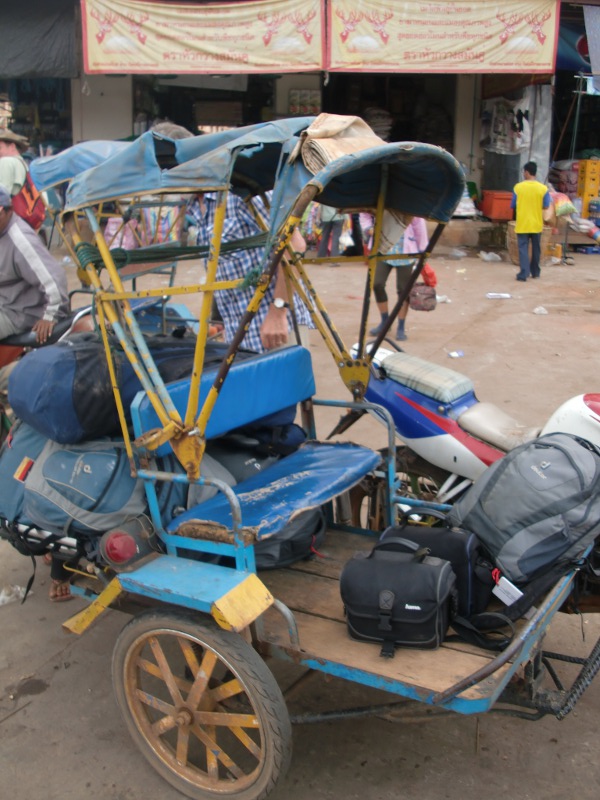
*That* is a tuk-tuk. Everything else is just a personalised sawngthaew!
[I was squashed with one of the Germans on the seat, the other German rode on the back of the motorcycle]. This was a short but interesting experience, especially when he turned left across two lanes of oncoming traffic, which from our vantage point we could see. Quite clearly!
Made it to the bus station in good time, got the ticket, then used up much of the rest of my KIP on water and a packet of Nori Seeweed flavoured fake Pringles. KIP is pretty worthless outside the country cos no bugger will change it, and due to my skilled money management I left Laos with approximately 30,000 KIP, which is about £2.50 worth, or one main meal at a decent restaurant. The bus to Udon passed without incident and soon enough I was on my own in a strange land with no maps and no phrasebooks!
Thailand, however, is quite a friendly place. Secondly, it is far more organised than Laos. It was pretty easy to find where and when my bus to Sisaket was due – I had enough time to change some money and get lunch. Pork in Oyster Sauce with fried rice for 45 Baht – just under £1. In a bus station. Fabulous! Plus, the bus ticket to Sisaket was only 40 Baht too, a journey of just under two hours. Quite a crowded bus too – as it was getting into the afternoon it was getting a little hot, but the bus was equipped with fans. At some point they stopped working but by then all the windows were open too.
My fear had been the next bit of the journey. I was right to fear it, but for the wrong reasons. I’d initially wondered if I’d have to source a taxi to cover me the whole journey from Sisaket to the Cambodian border (which would have been in the region of £35-£40), but in fact no sooner had I got off the bus in Sisaket than I was directed onto another bus which was apparently heading in the right direction. This bus was even more crowded at first, and there was virtually no legroom. At one point, the bus conductor actually got me to break a social taboo (!) – the back seat of a bus is always reserved for monks, if there are any. He’d directed me to the back seat after about half an hour, but soon afterwards, five monks came on. He got one of them to sit in the seat I was in, in front of me, and squashed the other four monks in around me! When more people had left, I excused myself and sat in a double seat a couple of rows forward – boy did I feel uncomfortable!
At the small town of Khu Khan, he indicated that this was my stop, and that I needed to do the rest by taxi. So yes, taxis were involved, but this was only 600 Baht (about £12) as it was only about 40km. However, this was no ordinary taxi …
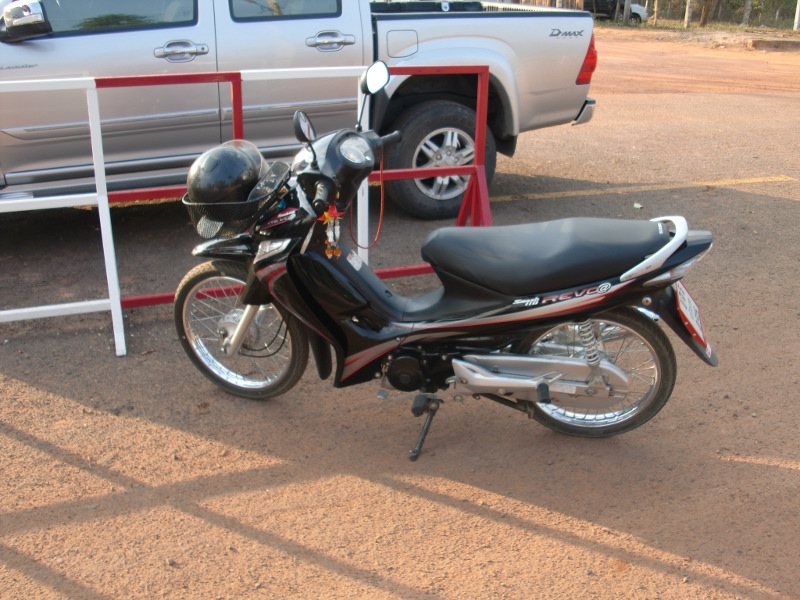
In Cambodia, taxis ride you …
… of course, I had a big heavy rucksack. The first thing we tried was me on the back wearing it normally. It was very lob-sided and we actually fell over after about 2km – the motorbike landing on my leg. Joy. Quick brush-down, fix my hat to my waist, check I haven’t lost anything, carry on. This time we tried it with me sitting on the backpack, which actually worked relatively well, although I was riding quite high so some of the trees on the main road were near misses. After we stopped for petrol, he tried a third tack and put the rucksack lengthwise between me and him. This was okay, but after a while it got uncomfortable on my arms to hold onto him around the pack. In any case my bum and legs were getting a bit numb by the end, but I couldn’t easily shift about because when I did, we weaved! I also couldn’t get decent grip on the footrests, possibly due to my position, possibly due to my footwear, but I couldn’t take them off as I’d nowhere to put them. The road I’d been warned about being absolutely terrible was actually pretty good; one or two rough spots but it was at least tarmac all the way, even if it was broken up at times. The only snag came from around 8km to go as the road generally went uphill, through some very picturesque countryside, but the poor bike could barely cope with it!
As international borders go, this one is quite quiet. Barely any traffic in either direction, the Thai border office is a portakabin, and the Cambodian immigration office is a shed. Well, to be more precise, it looked like an oversized football dugout or burger stall. And staffed with about 8 or 9 Cambodian border guards. All rather overkill.
Anyhoo. Visa processed and they let me in! Not sure how many English tourists they get but I doubt it’s that many. They got me sorted with onbound transportation to Anlong Veng – another mototaxi but this one was much more comfortable. We went faster on better roads, but the feel of the bike was more stable. Or maybe that’s the skill of the rider. Anyhoo, got to a hotel, actually the poshest one in Anlong Veng ($15/night!!!) but to be honest after a journey like that I’d quite like some pampering! The chap who drove me here was eager for any other business I could offer him, so have arranged for him to drive me out to Prasat Preah Vihear tomorrow – yes, the disputed temple.
I only did this after a bit of good fortune. The guidebook says that Anlong Veng only has one bank and there is no ATM. However, that guidebook was published in 2010. There is now a 24/7 ATM in a nice air-conditioned cubicle. So I thought I’d see if it worked with my card, after the debacle I had in both Malaysia and Laos. However, when I went to use it, three of the bank/security officials said it wasn’t working, that the computer was down and it would be back up in 30 minutes or so. (note that it seemed to be about to work fine for me). No matter, I had a wander through the town, picked up some food from the market food stalls, and then went back. It was working, and it worked! Cambodian ATMs dispense US$ mainly, and the market stalls here accept both US$ and Thai Baht, so I haven’t seen any Cambodian Riels yet.
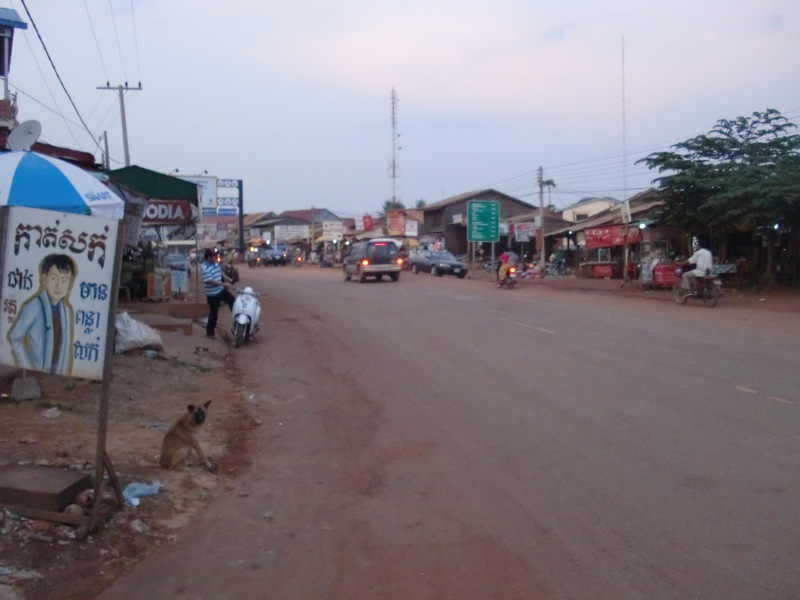
And I went through all that hassle to get *here*?!!
Anlong Veng. It’s not a pretty town. In fact it looks like someone dumped a load of sheds by a roundabout and said ‘I can’t be mythered to go any further’. There also appear to be no litter bins; there is rubbish on the streets almost everywhere. Plus it’s not very big. But in all that, it has its charms, and virtually everyone was saying ‘hello’ to me and so forth. I think they’re just amazed to see a tourist, tbh! None of them speak English, of course, and in all my travels I never managed to pick up a Khmer phrasebook. Also, 20 Baht seems to be the general price for things; I paid one stall 20 Baht for some dodgy meat-on-a-stick and she asked me if I wanted one or two of them … then I paid another stallholder 20 Baht for a piece of fruit and she then loaded the bag with several more small fruit of two different kinds as well!
But hey, I’m in Cambodia!! The other feeling I had was, partway through the motorbike trip in Thailand, I had the strange impression that I wasn’t really there? Like as if I was watching me in a movie or reading me in a book, that what was happening wasn’t really happening but merely a story. Like as if none of this is real. Strange …
Day 11: Wednesday 29 February –
Pol Pot and the Temple of Doom
Today I achieved pretty much all of my aims – both stated and unstated. Yay.
Moto chappie (whose name he did tell me but I unfortunately forgot!) came a-knocking for me at 7.40am; luckily I was already up. I wanted a reasonably early start because I knew it was a long journey, but equally I’m fully aware of my own limitations!
This time, travelling on the back of a motorbike was much more comfortable – as I only had my small red backpack as opposed to my big rucksack. In addition, I forewent the hat – useful as it might have been, it would have been awkward to take along (from the border yesterday I’d tied it to my belt-hook but then spent a good 10-15 minutes untying it again when I got to the room. Knots are *not* my strong point, as some of you may be aware … :p
It was a long journey – coming up for three hours – but we did stop twice for fuel and once for breakfast. Time has moved on quite a bit since my guidebook was written (July 2010), and what the book said were dodgy uneven roads had by now all been tarmacked, so it was a smooth and efficient ride. Less comforting was the sight of big trucks coming right at us driving over the central lines in the road, but closing my eyes made it all seem worse somehow. Plus I have no balance at the best of times, so keeping my eyes open was the best way of staying on the road!
Getting *up* to the temple (Prasat Preah Vihear – but it’s pronounced something like ‘Prasat Prav-eer’ to sort-of rhyme with the Indian cheese ‘Paneer’) is a slight faff. You have to go to the (off-the-road, so easy to miss) ticket office about 5k from the site, and “hire” another moto for $5 (access to the temple is otherwise free!). The reason for this is the state of the road up – it’s flat like one of those dusty construction roads, so perfectly rideable, it’s just *steep*. Most of it is steep like Church Hill near me or Littledean Hill near my uncle, so pretty step, but the last few hundred meters are … doable in a car, if the car is a 4WD pickup truck or some other redneck-powered vehicle!
From the ‘car park’ to the temple site itself, you walk down a long pathway that’s flanked my Cambodian soldiers, lookout huts, gun positions, and sandbags. Were you to look out to the left over the cliff, you would see Thailand. It’s fair to say that, on the issue of Prasat Preah Vihear, the two don’t exactly see eye-to-eye!
Basically, the temple’s always been in an area of dispute, but an ICJ ruling in 1962 finally gave it to Cambodia. Apart from ultra-nationalists on the Thai side, the temple itself isn’t in dispute now, rather a small area of land surrounding the temple is – this land wasn’t explicitly covered in the 1962 judgment. And ever since then the two sides have been ‘on guard’ on and off. There used to be direct and easy access to the temple from Thailand but the border here gets opened and closed on a regular basis (currently, it’s closed. With razor wire!). Note that the British Foreign Office’s Travel Advice for pretty much the whole border area, specifically including the temple but probably also covering Anlong Veng, is ‘don’t go there’. But what do *they* know?!
The temple itself is from the Angkor period (so of the same mould as the *huge* Angkor Wat temple in Siem Reap), so is nationalistically Cambodian, although at times in history the Thais have even controlled Angkor (the French made them give it back!).
As ruined temples go, Prasat Preah Vihear is actually pretty spectacular. It’s partly because, although in ruins, it’s actually kept pretty well. You can still make out quite a few of the designs on the porticos and on the walls themselves, plus you can quite easily get a feel of what the site must have looked like in its prime. In that respect, it is far far more spectacular than Wat Phu Champasak.
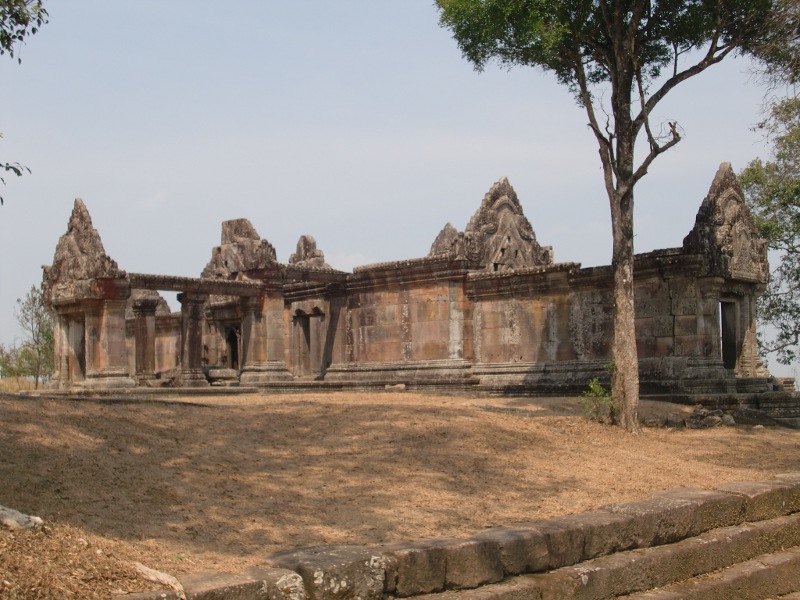
Definitely worth visiting – this is just one small part of it!
However, it’s partly also its location. On the ride on the way there, the surround countryside was flat and quite dull – rough fields of grassland and landmines, punctuated by series of small trees and the occasional rough-and-ready villages. However, as intimated, the temple is on a hill. In fact it’s built *on* the side of a mountain – the outline follows the contours of the mountain so as you move South, you also move further up. (This is also why access is easier from the Thai side. The ‘entrance way’ of the temple is on *their* side of the mountains!). Obviously this means that the views are awesome. Or would be if Cambodia wasn’t suffering a similar amount of haze as Luang Prabang was. Guess that’s the drawback of this time of year.
There weren’t that many people there – a few Cambodian families -; in fact I’d say the tourists were outnumbered by the soldiers who were sitting on pretty much every portal and getting in the way of photography! I think moto-man was tipping them some small cash for their presence; I was too busy taking photos!
After we’d been there about an hour and a bit, Moto-man started to make suggestions that it was time to head back, as it was a long way home. To be fair though, by this time I’d reached the ‘viewpoint’ over Cambodia so there wasn’t much else to see. I ate a bit of fruit (it’s hard to eat a melon without a knife!), then we headed back down the mountain and set off for the ride home.
Getting back wasn’t really that memorable – quicker than the way there, taking only just over 2 hours. But then we didn’t stop. Not even for petrol, so we cruised into Anlong Veng having been running literally on empty for about the last 35km. I don’t think *he* was quite sure how we did that. Gave him $60 for the trip, which sounds expensive, but there’s really no other way of doing it (there are very limited buses to the town of Sra Em, but even that’s still 27km from PPV, and Anlong Veng is some 90km from PPV). Then had a rest in the hotel cos my bum was sore!
Headed out an hour or so later, to start the second part of the reason for going to Anlong Veng. This is slightly more unpleasant, and is part of the reason I chose to go to Cambodia in the first place. Most tourists come here because of Angkor Wat. I came because of the Khmer Rouge. In the whole of the 20th Century, I can’t think of any other regime who killed as large a proportion *of their own people*, especially not in such a small space of time. Sure, they only killed 2-3 million as opposed to the Nazi’s 6+ million, but the Nazis had a larger base to work from (Germany’s population alone was bigger than Cambodia’s, plus the Nazis worked off most of continental Europe). The Khmer Rouge killed roughly 20-30% of the total population of Cambodia. In 3 years and 8 months. Compared to that, Hitler and Stalin were minor irritants!
Hopefully later in the holiday, once I reach Phnom Penh, I’ll go into more detail about this, but as for now the question is: What does this have to do with Anlong Veng? Well, when the Vietnamese invaded and overthrew the Khmer Rouge over the winter of ’78-’79, the regime fled northwards into what was then dense jungle near the Thailand border. Over the course of the next two decades, with non-attributable help from Thailand and the USA (*), the Khmer Rouge were more than a thorn in the side of the central government in Phnom Penh. They made Anlong Veng their ‘base’ out of which they operated, and it is here (and PPV) that they were finally defeated in April/May ’98. The leader of the regime, Pol Pot, ‘mysteriously and conveniently’ died of a ‘heart attack’ as Anlong Veng fell – he had already been overthrown from the Khmer Rouge leadership some months earlier and was under their house arrest at the time. And then cremated very quickly afterwards. Mmmmhhh.
(* The USA don’t come out of this particularly well. Having bombed the heart and soul out of the country in the early 70s as part of their doomed efforts in the Vietnam War (and probably encouraging support for the Khmer Rouge), they then ignored the excesses of the Khmer Rouge regime at its height. When Vietnam invaded, they took the view that the KR were the legitimate government, although this may be because a bunch of pseudo-communist genocidal maniacs is better than a ‘real’ communist! There were rumours that training and funding for KR guerrillas in the 80s was provided by the USA as part of the Cold War. Yeh.)
Anyway therefore, Anlong Veng has a number of sites surrounding the Khmer Rouge leadership. The first one I went to was the house of Ta Mok, the military head and ‘Brother Number Five’ in the regime. It’s a weird shell of a place, a couple of hundred meters off the main road (most of the good stuff was looted soon after he was arrested in ’98). What remains are some of the flooring, and the murals on the walls – depicting scenes from both Angkor and PPV. It overlooks a lake. Or rather, it overlooks what once might have been a lake, and which is now grasslands containing pools of water, with the whole thing covered in dead, gnarled, trees (apparently the water poisoned them). It’s a little eerie. Children now go fishing there. On a side note, the house now also seems to be used as a kind of ‘play/activity/social centre’ for the whole family, as when I was there the place was full of people chatting, running about, using laptops, having picnics, and playing games. One room I walked into I got mobbed by maybe 20-25 teenagers who all insisted that I have my photograph taken with them. Individually. Am I the tourist, or the tourist attraction?!
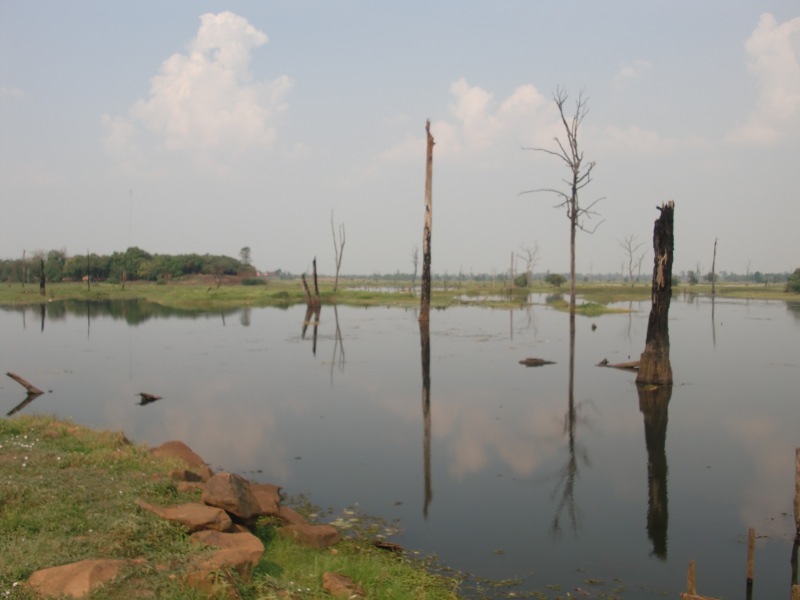
Ta Mok’s Lake. Huge, but dead. Kind of … eerie and lonely.
The other sites were a moto-ride away, up by the border I crossed yesterday. I could have seen them then but I just wanted to get to the hotel. So today, walking up the road, I got hailed by a passing moto driver who wanted to know if I needed a ride. After trying to explain to him where I wanted to go (he didn’t get it at first, but then a lightbulb went off when I showed him Pol Pot’s name), off we went.
There are a number of sites ‘beyond’ the border village that I really couldn’t be mythered to get to, and one site (Ta Mok’s grave) that I couldn’t actually find, but the place I wanted to go was Pol Pot’s cremation site. It’s now a ‘shrine’ – people believe his spirit will grant them the winning lottery numbers, and long ago, anything that remained from his ashes was taken as souvenirs. It’s very close to the border (maybe a couple hundred meters), but easy to miss as it’s down a side road. It is signposted though.
Rode back to Anlong Veng, then had a wander about town for some nibbles, and while I was there I booked my bus ticket out to Siem Reap for tomorrow. At 7am. Yikes! As for food – the Cambodians like to snack, so every other market stall is one cooking some kind of meat (I generally don’t ask what) or selling some kind of food (again, best not to ask). I picked up, I dunno, they look like deep-fried very small frogs. That they’re deep fried means they taste like a KFC. And you eat them, bones and all (a bit like whitebait). Yeh…
After another rest in the hotel, I went out for proper evening meal food. It was dark by now (and Anlong Veng has no streetlights, but still very very warm. Psychologically confusing. I forewent the hotel’s own restaurant, and in town saw a fairly large stall with tables where some people were eating. I sat down. On my table was then placed a tray with vegetables on ice (carrots, shrooms, herbs, and one or two other unidentifiable things), another tray with flavourings and condiments, and a small mixing bowl. This is similar to Laos, but even more do-it-yourself; you mix the flavourings in the small bowl, then apply to the meal, which in this case, was ‘cow’. Note that none of this I asked for! So to some pre-made saucy stuff I added a lot of lime, some peanuts, some sugar, onion, and a small amount of chillies, so in effect I made my own satay dip! Fab food, just what I needed. As I was eating, a couple of other tourists came by, which surprised me as I expected to be the only Westerner here. They were doing what I was doing, pretty much – passing through from Thailand having been to Laos (although they came through Thailand further North, from Savannakhet).
Got some water (I’m drinking a lot more in Cambodia than I did in Laos), and headed back to the hotel. I think I now understand the Riel a bit better now: there are 4,000 Riel to $1. A bottle of water costs 500 Riel. This means moto-man is now quite rich :p
One final note: ice-cream vans. In the UK they play ‘Greensleeves’ or that ‘boys and girls come out to play’ song. In Cambodia, the one I passed was playing ‘Fur Elise’. More elegant, huh?! Conversely, the ones I passed in Laos all played the ‘Mexican Hat Dance’ …
Day 12: Thursday 1 March –
Tomb Raider
Bea Marshall Quotient : High until lunchtime, afternoon minimal due to heat.
I’ve never seen the film ‘Tomb Raider’, obviously, as it’s a film, but my guidebook says that a small part of it was filmed amongst the temples of Angkor. At least I had forewarning, not like the time I walked to the Philadelphia Art Museum and thought ‘coo, that’s odd, there’s a statue of Rocky at the bottom of the steps leading up.’ …
I’ve found out why I was drinking so much water – towards the end of yesterday my eyes were drying up. Of course, I was sleeping in a room with strong aircon! It was necessary, but it explains a lot.
Got up, and caught the bus nicely. It was a pretty standard coach, in all honesty, nothing unusual. We left a little late though as we had to wait for a few bags of rice to be loaded on … journey was pretty smooth; we stopped off for a breakfast halt near a roundabout in the middle of nowhere, and as the coach was bound for Phnom Penh, passengers for Siam Reap had to change about 20km outside the city onto another coach, which was even more swish!
Bus station shenanigans (they’ve moved it again!), but as I hadn’t booked anywhere anyway, I was at the mercy of the touts. Or possibly they were at the mercy of me as I played them off against each other. $15/night again, but it is a rather luxurious hotel, complete with minibar … mmhh! I’m taking the view now that, yes I can spend $6/night on a room, but since the cheapest hotel I stay in often in the UK (Formule 1 Birmingham) is about £25/night for which you get a bed … $15 is less than half that and I get aircon, decent bathroom, free Wi-Fi … I might be on a budget but it’s not a pocket-pinching one!
The chap who took me to this hotel – Sinpon – stayed with me as ‘my moto driver’ for the day. He’s cool, bless him, but he does like things his own way, and having random Englishmen like me only confuses him. Anyhoo, as I settled into the hotel towards 10am-ish, I figured it was a bit late to do what I was going to do, so we set off to see the temples of Angkor. Which I had initially planned not to do …
It’s a very long, straight, road from Siem Reap to the temples, longer than it looks on a map. Paid $40 for a 3-day pass – even though I’m only staying for two, it’s easier than getting two 2-day passes for the same price … Anyway. First stop, Angkor Wat, the largest religious building in the world.
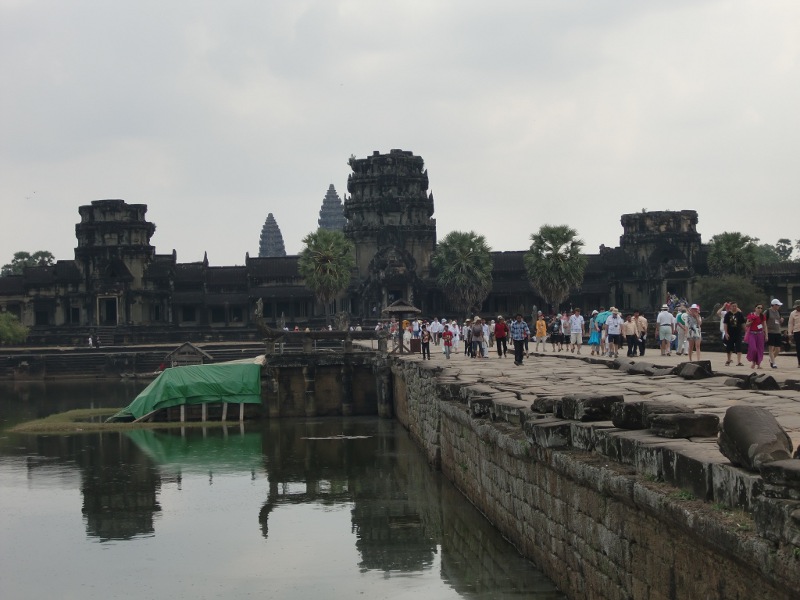
The entrance to Angkor Wat, with the distinctive towers in the background.
It is actually huge. On the map it looks like a small square, until you realise the scale of the map. This caught me out later on too (the entranceway causeway *alone* is 500 meters). It’s full of very well-sculpted murals and bas-reliefs, patterns on porticos etc, and it’s all very symbolic. The trouble is, after going round two entire walls depicting battles, you kind of lose a sense of concentration and they all merge into one.
And that is the very problem with the Angkor complex. Lots of temples, all with different designs, sculptures, etc, and yet all depicting similar mythologies and art. An art historian or Ancient Oriental History major would spend a full week here dissecting every single one of them. I am not. Although that said, Angkor Wat is prettier and somehow slightly more impressive than Prasat Preah Vihear – what it loses in location it makes up for in intricacy and sheer size – you can’t help but be overawed by it.
After grabbing lunch on site, I went back to Sinpon and he took me several km East, to the temple of Banteay Kdei. From here I told him I’d walk to Angkor Thom’s South Gate, almost back to Angkor Wat. He didn’t believe me, and said he’d wait for me at Banteay Kdei. Heh. This was nearly 1pm. Banteay Kdei is quite a quiet ruin, as most tourists ride straight past it on the way to nearby Ta Prohm, but it’s pretty in its own way.
Ta Prohm, on the other hand, is quite weird. There are trees growing inside it – not overgrown with trees, but enough there to make you realise (as the trees are quite old) just how old the ruins are. They’re also still reconstructing/renovating it so much of it is closed off. The most popular part is a weird tree that apparently featured in a prominent (and weird) scene in the aforementioned movie.
There was then a long walk to Angkor Thom – *much* longer than it looks on the map. It was really hot out, but I tried keeping myself cool by drinking lots of water (on sale at virtually every corner) and the occasional mango. Yeh, wherever you turn, there are hawkers trying to sell you stuff (mainly cute kids, annoyingly); all, oddly, for $1. So a bottle of water, a mango, a T-shirt, and a guidebook to Angkor are all $1. Apparently. Someone doesn’t have much business sense …
Wandered past a couple more temples (Ta Keo, Spean Thmor, Chau Say Tevoda) before reaching Angkor Thom’s Victory Gate. Angkor Thom is a *huge* area contained within boundary walls – but the main site itself is over a mile from the entry gates, and the bit in the middle is a nice country walk! I headed down a quiet path to get to the obscure but well-regarded East Gate, before heading towards the centre, and the rather bizarre temple of Bayon.
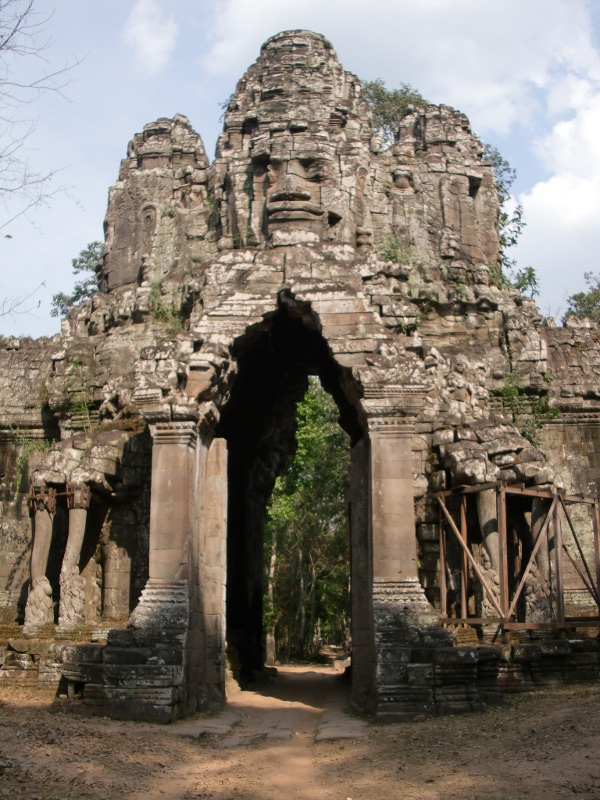
The East Gate to Angkor Thom. Ugly bugger sitting legs wide apart.
By now I was actually suffering pretty badly from exhaustion due to the heat, so when I reached Bayon I sat down in the shade for about 15 minutes, then grabbed some water. I wandered through Bayon – a mishmash of architecture seemingly built as a self-glorifying edifice by one of the Kings of Angkor (Jayavarman VII, if you care!). Didn’t give it as much recognition as it probably deserved, but by now I was exhausted, too hot, feeling ill, and pretty much templed out. I failed to walk the rest of the way, grabbing a tuk-tuk instead.
After a long wait, a rub-down with a large block of ice I got from one of the water sellers, a phone call, and my nearly throwing up in the moat surrounding Angkor Thom, I finally managed to grab Sinpon (about 4.45pm) and he rode me back to the hotel. Apparently he hadn’t believed me when I said I’d walk, so he’d been waiting back at Banteay Kdei, then wondered where I’d gone, rode around trying to find me, asked a policeman if he’d seen me, etc! Anyhoo, all’s good now. I’ve arranged for him to come pick me up at 8am tomorrow to visit a couple of the more distant temples – but we’ll be on a moto most of the time so hopefully I’ll feel jolly fine! Collapsed back in the hotel room – sometimes aircon *is* A Good Thing!
Day 13: Friday 2 March –
Sticks and Stones
Bea Marshall Quotient: Beyond the Pale.
Sinpon met me outside my hotel at 8am, and we headed off for day two of the ‘OMG not another bloody temple’ experience. Still just as hot as yesterday, but this time we were headed out into the sticks, for just two different sites. So not as much walking as yesterday? Yeh, right …
Side Note: Cambodia, as has been pretty self-evident so far, is the land of the motorbike. The impressive thing is what you can see *on* these small motos:
* One chap was riding with a thin block of wood, which must have been at least three meters in length.
* Another person we passed was carrying at least two, possibly three, double mattresses on the back of their moto.
* Then there was the teenage girl riding one, with what I assume were her three younger sisters on the back – so four kids on a bike!
The other issue I’ve got with motos, and this applies in Siem Reap more than Anlong Veng, is that the average moto driver does not differentiate between the road and the pavement (AV didn’t really *have* pavements). Several times while walking down the main road earlier I got *cut up* by a moto. Oddly, road rage doesn’t happen here. People honk their horns, but *only* when passing slower-moving traffic (a sort of ‘look out, I’m behind you, get out of the way’ honk). They don’t seem to use the horn in anger, like the West, or in boredom, like the Maghreb.
Anyhoo. Our first stop was the Cambodian Landmine Museum. I’d seen it in the guidebook but didn’t know really where it was, until we passed it and Sinpon said ‘you wanna go’? So I did! Interesting place; set up by a chap who originally *laid* mines in the days of the Khmer Rouge, but who has since made a career out of mine-clearance and defusing them. For many years, he was a solo operator, clearing mines with a stick (!) in low-priority areas and small villages, but in the late 90s the international mine clearance bodies said ‘we don’t know what you’re doing’ and told him to stop. His response was to get trained up to do it properly! The museum’s not that big, but it has examples of what bombs and landmines look like, who uses them, why they’re used, and how they’re cleared. In the case of landmines it’s with a dirty great big machine and lots of protective clothing. No rats.
The second stop was another temple – the outlying Angkor temple of ‘Banteay Srei’. What sets this temple apart from the others (apart from being in the back of beyond) is its impressive artwork. Quite a lot of the temple has been restored/renovated, and the decoration on the sides and the door lintels is quite impressive.
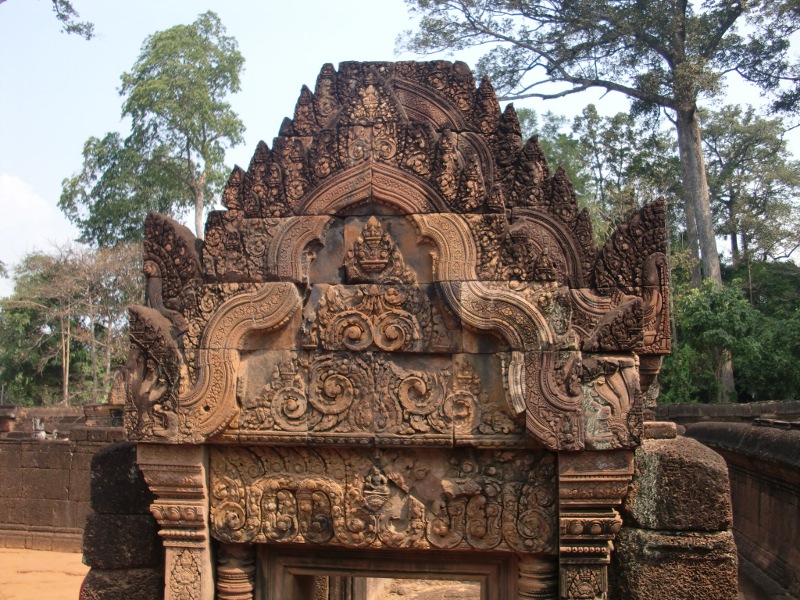
See?! Pretty!!
It seems to have served as both a temple and a government building, or at least had more than one use – the front half appears to have been accessible by anyone but the rear end only by high-ranking officials. Its more recent history was kick-started when, in the 1920s, future French thinker, politician, and chap who my friend Leila’s school was named after (Andre Malraux) decided to nick bits of it and sell them (it wasn’t one of the designated ‘protected’ temples of Angkor at that point); it was decided this was a *bad* thing and work started pretty soon afterwards to renovate it!
Our next (and final) destination was Kbal Spean (the ‘bridgehead’) – a river with lots of ornate carvings in and around it. While the name refers to a natural rock arch over the river, its other name is ‘River of a Thousand Lingas’, as many of the decorative effects in the riverbed are of lingas. The tips of Penii, yes.
However, while the river itself is quite pretty, serene, and interesting, *getting* there is another matter. From the car park, there is a nice picturesque 1.5km pathway through the woods and up a gentle hill.
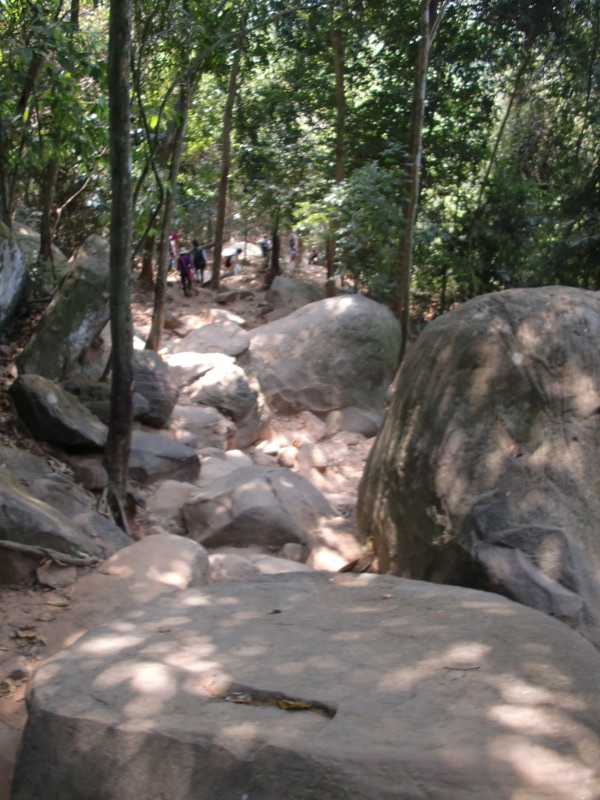
LIES!!!!!! ALL LIES!!!!!!
It’s picturesque, certainly. I wouldn’t go so far as to say it was a path, though. In fact, if there hadn’t been markers every 100m, and other people doing the same route in either direction, I’d be hard-pushed to tell you there was a path there at all! It’s fine for the first 100m, then the rocks start. A combination of clambering over rocks, and across tree-trunks, make it quite the adventure. At one point there *is* a flight of steps, but other than that you’re on your own. Getting *down* is actually harder than getting *up* – there was a bit around the 800m mark where it was literally a leap-of-faith job.
The trail itself was dusty, although relatively smooth. After about 400m of rock-climbing and slipping on the dust, I figured my dodgy old walking sandals weren’t giving me enough grip, so I took them off and clambered the rest of the way up barefoot. I did feel a little like some kind of ancient hunter lol.
The top of the trail is the rock bridge itself, and the river flows nicely through some small rapids. It’s very serene and scenic. Up here there are a few carvings, but then the trail goes slightly downhill alongside the river, and as the river flows down, there are a lot more carvings and decorative effects, both on the bank (such as Shivas carved into the stone) and in the river-bed itself (mostly linguas).
The trail ends at the bottom of a waterfall. Even in the dry season it’s quite nice, so would imagine in the wet season the thing would be gushing. And after a long hard climb in the heat (bear in mind that clambering over rocks requires more effort than simply ambling along!), standing in a cool river by a waterfall is incredibly refreshing!
I headed down (sandals *on*; it seemed to be easier going down), nearly slithering down the hill at least twice, and eventually, completely knackered and way too hot, made it back to the car park and straight into one of the many food stall restaurants on site. What I have now learned is that it doesn’t matter how much water you have, heat exhaustion is just as bad if you haven’t eaten!
I did want to go to another site – Beng Mealea – but it’s completely out the way, I was knackered, Sinpon wanted a further $20 to do it, and I was getting cranky on the back of the bike, so we didn’t. Rather, he took me back to my hotel and I collapsed in a heap on the bed!
Evening was quite dull; had a wander down the main road, bought some fruit from a market stall (I’ve no idea how much fruit I can buy with 1,000 Riel – and I don’t know how much a mango costs but it seemed awkward to give a 2,000 Riel note and expect change! I’m sure that’s far far too much, but I don’t want to be stuck with 500 Riel notes!). Found a small restaurant near the hotel that had a menu in English, Khmer, *and French*, and sold things like ‘stuffed frog’. Nope, didn’t ask what it was stuffed with!
I have no idea what to do tomorrow – either stay in Siem Reap or go to Kompong Thom. I’ll probably stay in Siem Reap though: I haven’t seen anything of SR town, and also KT has a couple of pre-Angkorian temple ruins and a holy mountain pilgrimage site. So a bit too much like today, really!
Day 14: Saturday 3 March –
Amok Time
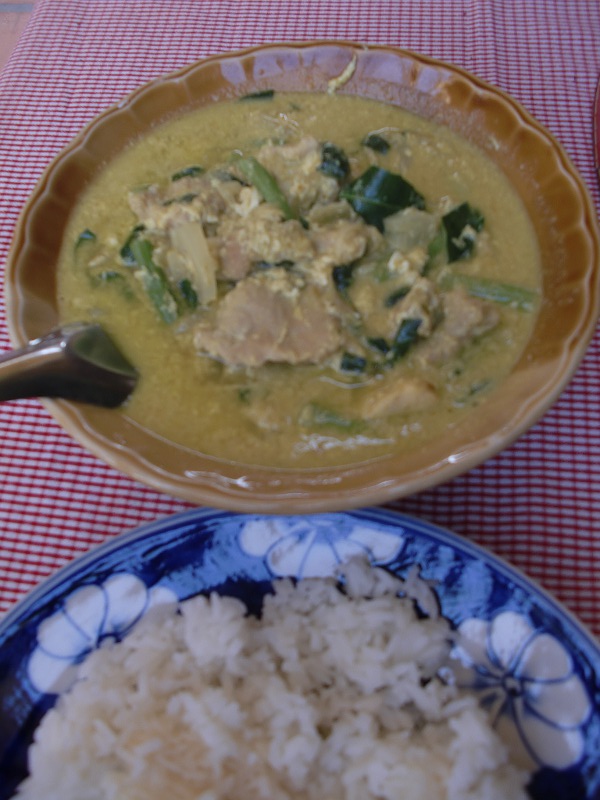
Not a classic TOS Star Trek episode, but a curry!
Today was a day of rest. I thought I was in need of one! Plus, oddly, it would have been more expensive to go to Kompong Thom anyway, as although the hotel would have been cheaper, bus companies on the Siem Reap-Phnom Penh route have a habit of charging ‘one fare, one ride’; ie the price to KT would be the same as to PP, so in effect I’d have had to pay twice the travel cost, which would have been more than the difference in price between the hotels.
Also, I couldn’t be mythered.
What I *did* do was go for a walk into the main touristy bit of Siem Reap. Well, three walks, actually. The first in the morning to check out what was there, the second around 3pm to eat lunch, and then the third just before 6pm to have a look at the night market and to have some evening food. Unlike Angkor, the map doesn’t lie – tuk-tuk drivers say it’s a long way, and when I say ‘no it’s not, it’s only 2km’ they kind of laugh and say ‘yes, 2km, long way’. Evidently tourists are lazy … * looks up at the sky, feels the sun burning, hmmm … 😉
The centre of the city is quite a Tourist Trap – there is a road called ‘Pub Street’, for instance, that consists entirely of restaurants and pubs. Near it is ‘The Alley’ which is a narrow pedestrian (ha!) street consisting entirely of shops, restaurants, and pubs. There’s also ‘The Lane’, which consists of … you get the idea! It’s slightly more expensive to eat in than Anlong Veng, but let’s be honest, that’s like comparing Manchester to, say, Grimsby.
There’s also a big difference between daytime and nighttime. In the day it looks quite quaint, lots of little shops etc, but it also looks a bit empty – because all the tourists are looking around the temples. At night, however, most of the roads in the very centre are closed off to traffic, the whole place it lit up with garish lights, and it’s like the city has discovered what it feels to feel the vibe of life!
As a side note, ‘Siem Reap’ has an interesting etymology. Given its location and its history, compare that with its geographical location, and be amused that it means ‘Siam (Thailand) Defeated’. Especially as *the* main border crossing into Thailand (Poipet) is a hundred or so km up the road. It would be like, I don’t know, ensuring that voyagers from France arriving into the UK would enter London at somewhere called ‘Waterloo’. Heavens that would never happ…well, not any more, anyway 😉
So, this morning I had a wander around and down, getting used to the traffic now and crossing the road only when it is safe to do so (which involves quick calculations as to the apparent speed of the oncoming motos, likelihood of them turning a corner, and making sure that someone else is between me and the oncoming traffic). Parts of the city are quite pretty; indeed my hotel is right next to the Siem Reap river. By day it lies between two large grass verges that separate two opposing carriageways of a main road (the gap between the roads is thus so wide that it doesn’t feel like a main thoroughfare at all) – and in fact the area just beyond my hotel over the bridge is the ‘Royal Residence’, a very nice landscaped area with colonial-esque buildings by it – there seemed to be a wedding going on when I passed; by night there are lights in the trees and the benches along the path are filled with canoodling couples. And, at one point, someone sleeping in a hammock that was tied to two trees and completely blocking the pavement. However, as I walked round it, some policemen were there telling him to take it down …
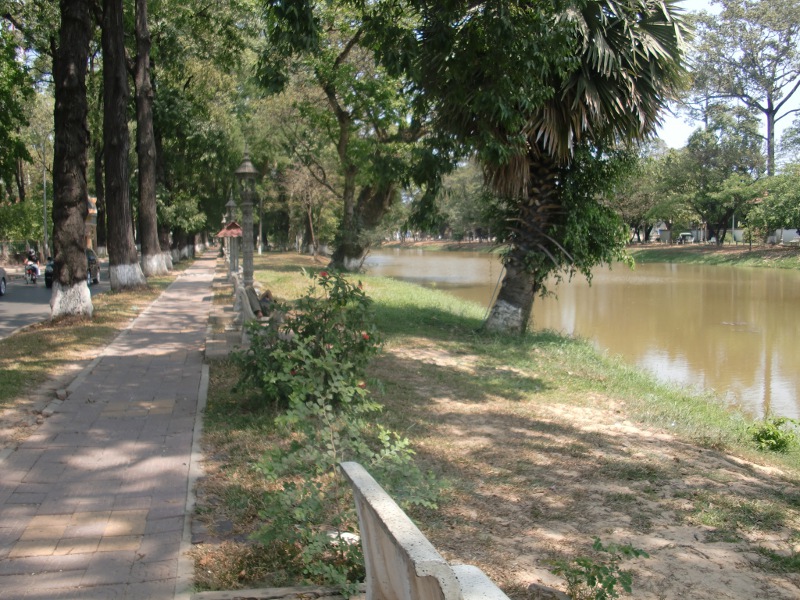
Hard to imagine, say, the River Rea in Birmingham looking like this!
My first stop was a rather odd place near my hotel, down two side-streets so not a place easily found. Someone has created miniature representations of a few of the major Angkor temples, including Angkor Wat, Bayon, and Banteay Srei. Is very odd, but also quite detailed. If that wasn’t odd enough, there’s a back yard area where there’s a swimming pool surrounded by stone crocodiles. Yeh …
Had a look around the market – selling the usual tat, but also lots of spices. Not that I’ll be taking any back (my backpack is about as full as it can get, or at least it is when I put my daypack in it), but makes me want to get hold of a few of the recipes to try at home. T-shirts are, metaphorically, a ‘dime a dozen’, as are dodgy metal bracelets. The Night Market was the same, except with more lights and cheesier restaurants/bars.
‘Lunch’ I grabbed on my second trip out, around 3pm (and the heat was still intense!), and was the aforementioned ‘Amok’, a particular style of Cambodian curry. It’s quite mild, compared with cuisine from neighbouring countries, but also flavoursome (lemongrass, especially). Most restaurants offer it – traditionally it appears to be mainly a fish curry but the place I went to offered several meats, as well as both tofu and ‘vegetables’.
Evening saw it a little cooler so I had another wander down, and saw how much it changes overnight. Much busier, but also then that much more interesting. I decided to waste half an hour by trying one of those ‘fish-eating-foot-massages’ (they seem to call themselves ‘Dr Fish’ over here); well it was $3 for half an hour, and a free drink, but after I’d been in there maybe 15-20 minutes, a couple from the Home Counties came by and joined me – *they* were there for maybe 35-40 mins before they decided they’d had enough! It’s very *very* ticklish at first but after a while it just feels like rain. *And* when the others stepped in, all the fish left me and went to them instead!!
Have booked my bus to Phnom Penh (departs 9.45am, hotel pickup 8.45am, so no need to rush getting up tomorrow); have also booked hotels in Phnom Penh and Singapore. The end is nigh! Interestingly, the hotel in Singapore is one of the cheapest I could find, and yet it is still more expensive for that one night than my entire four-night stay in Luang Prabang! Good job I decided to spend an extra day in Cambodia from my original plan then, really!!
Today was also the first day since Monday I didn’t ride on a moto. My bum is quite grateful!
Day 15: Sunday 4 March –
Remember, Meeting Expectations leads to Customer Satisfaction
But first, a joke:
“Waiter Waiter, there’s a fly in my soup.”
“Yes sir, this is Cambodia.”
Today was not a very interesting day. I spent a comfortable six hours on a pretty decent coach, sitting at the front so got to see the road ahead of me. There are a whole plethora of coach companies who operate in Cambodia, mainly on the popular tourist routes (I think I could have chosen from at least *nine* for today’s journey from Siem Reap to Phnom Penh). I chose one called ‘Mekong Express’ who, at $11 for the trip, are mid-to-high apparently but the service is good – free 2xDanish Pastry and 1xwater, plus hotel pickup for free and easy arrangements made for onward tuk-tuk to hotel in PP. There have been reports of cheaper coaches crashing on this route. It was a smooth ride most of the way, but the last 50km were still being built – roadworks everywhere and the tarmac already laid was quite ‘bitty’ and rough.
The coach I’d got on Thursday from Anlong Veng was run by GST, a slightly cheaper company but I think they’re one of the few who actually do that route. In actual fact, both journeys were similar – aircon coach with one food stop, plus TV ‘entertainment’. Both coaches showed (in fact I think the *same*) collection of VCD Karaoke videos of Khmer Pop; in fact the whole VCD was several songs in a storyline of ‘boy meets girl, they fall in love, shit happens’ – late teen girl-pop ballads. * le sigh.
Thursday’s coach also played some Khmer ‘sitcom’, again aimed at that tween market, that seemed to have a fairly inept Che Guevara as one of the main adult characters, and two gormless geeky-type twin teenage boys in matching yellow/black sweaters and glasses who, well, had no gorm. Magic was involved somewhere. Today’s coach had some bizarre Khmer vaudeville stand-up comedy act involving singing, a documentary in English on Angkor Wat (useful having just *left* the place), and the film ‘Live Free or Die Hard’, in English (with low volume) and what I assume to have been transliterated Khmer subtitles (though it could have been Vietnamese).
Our lunch stop was, interestingly, Kompong Thom, where I’d decided not to stop over the day before. Quite a rough-and-ready town, but still more structured than Anlong Veng. Most people nipped into the main big hotel for restaurant lunch, but I hung around the market stalls outside and feasted on 1,000 Riel worth of …
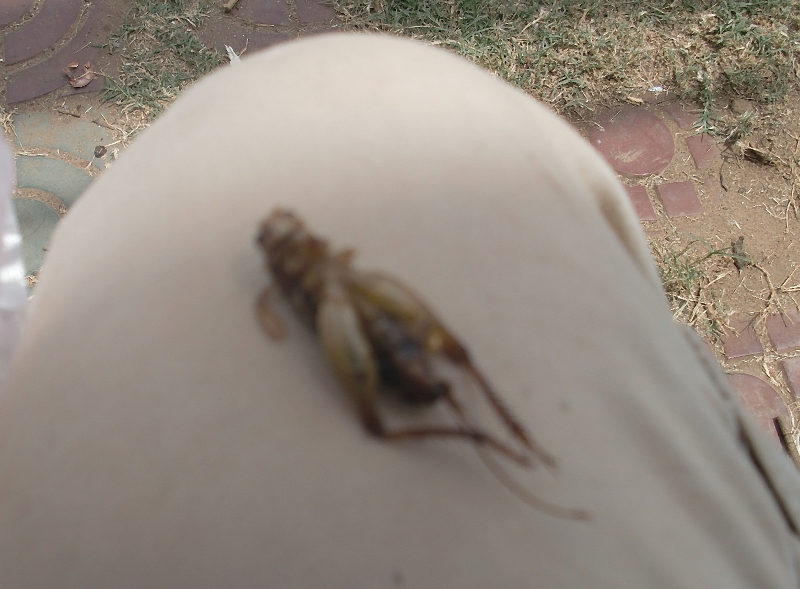
Slightly crunchy, had to be careful the sharp bits didn’t stick.
Now. This leads to two ethical questions:
#1 – For the carnivores: what’s the difference between eating insects and eating cows and pigs? They’re both animal.
#2 – For the vegetarians: if you’re veggie on ethical principles, if you could effectively ‘pluck’ insects out the sky as they’re flying past and eat them, the way that most other animals do with prey, would that be more acceptable than farming foods?
It is often said about Cambodia though that one of the reasons they eat things like insects and the strange mini-frog things I had in Anlong Veng (and one of the towns we passed through to get to Phnom Penh, Skuon, is famed for its fried spiders!), is because relatively recently, that was all they *had*. Food was so scarce during and immediately after the Khmer Rouge regime that they had to survive on what was available – that includes insects. Note that they always seems to be deep-fried, so they don’t really taste like anything much other than crunchy and slightly greasy. Again, KFC springs to mind …
Anyway. Got into Phnom Penh sometime between 3.30pm and 4pm. It’s bigger than Siem Reap, and there are more (narrower) main roads, so there’s much more traffic. Is it safe to drive here? Absolutely – as long as you’re in the biggest tuk-tuk! On a side note about traffic, while Cambodia has a lot of motorbikes, the most commonly seen car appears to be a Toyota Camry. I’m not altogether sure why.
After getting to the guesthouse, I had a quick wander down a couple of the local streets, and had a late lunch in one of the *many* bar/restaurants round here. Sitting by a busy street corner, surrounded by greenery, with 80s rock in the background (Neil Young, the Cult, Eddy Grant, some 80s version of Thin Lizzy songs), just made me think weirdly that it felt exactly how I would have imagined it would have done – or rather, if someone had asked me to describe what it would feel like to be in a large city in Indochina, what I’m experiencing is pretty much what I would have said – noise, traffic, food, life. In actual fact, sitting in that bar made me imagine what Saigon may have felt like had the Americans won. Strange.
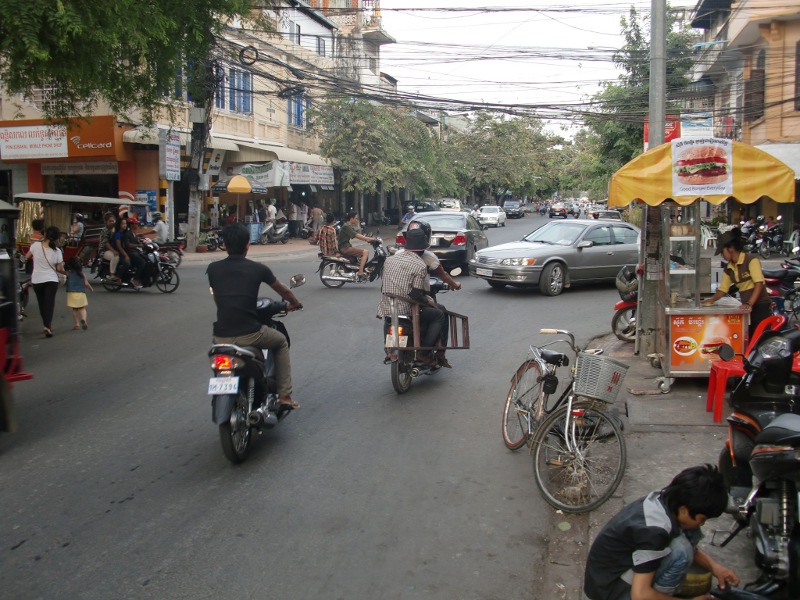
The local crossroads. No need to panic yet.
Had a bit of a rest before evening meal, which I took at the guesthouse’s own cafe-bar. Sitting outside in the street in the cooler night air, all still seems quite surreal! Having to watch my money though, not because I don’t have any, but because even the hotel might baulk at my paying for a $4 meal with a $50 note … lol!
Day 16: Monday 5 March (Part 1) –
Punishment Park
Because you need to see this. Everyone needs to see this. Make no bones about it.
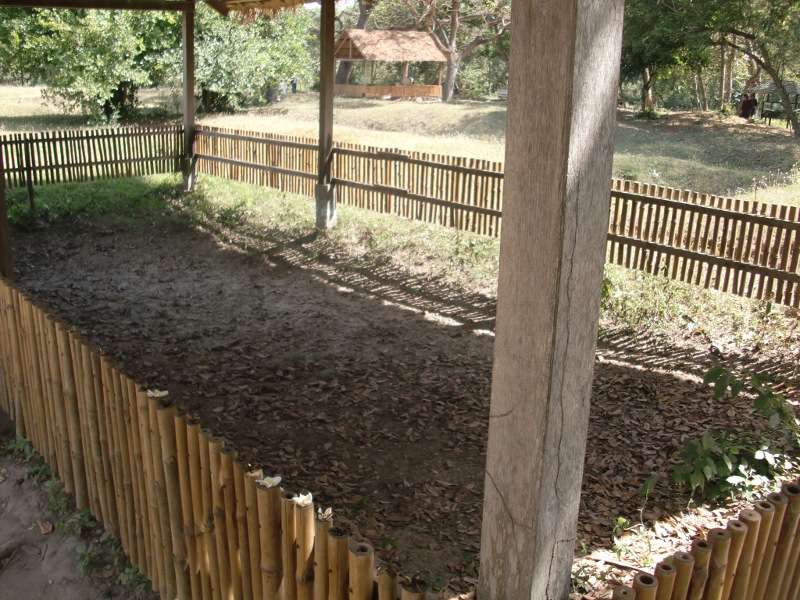
This is the site of a mass grave of 450 victims. Peaceful, now.
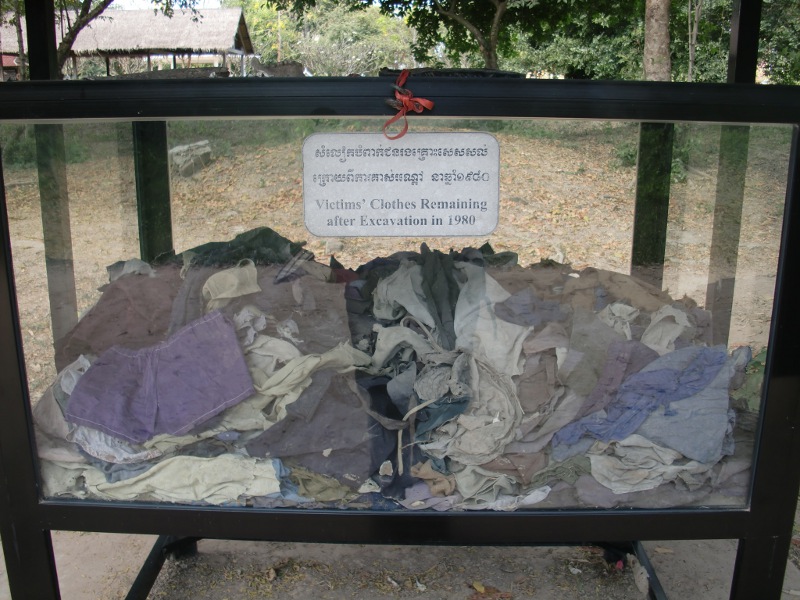
Remains of clothing found upon liberation and excavation of The Killing Fields
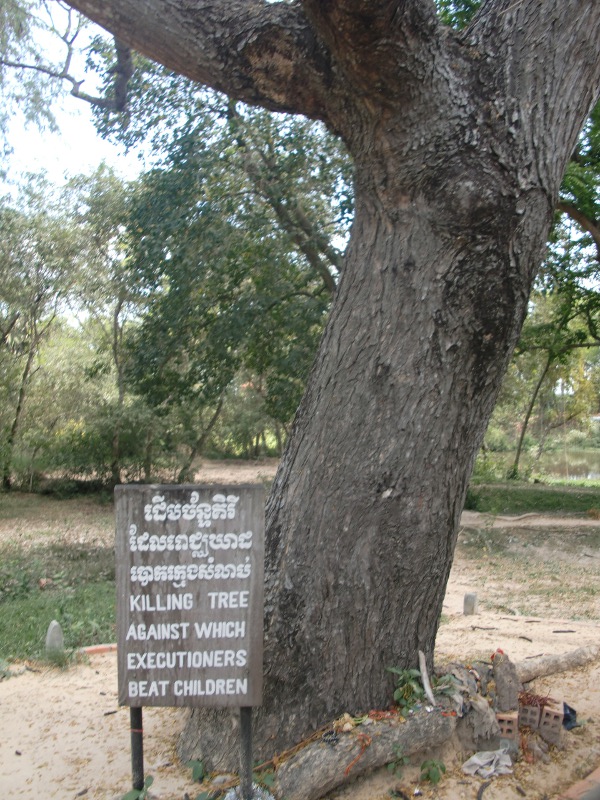
Khmer Rouge guards swung babies and children round by the legs and smash their heads against this tree. I *told* you to be prepared!
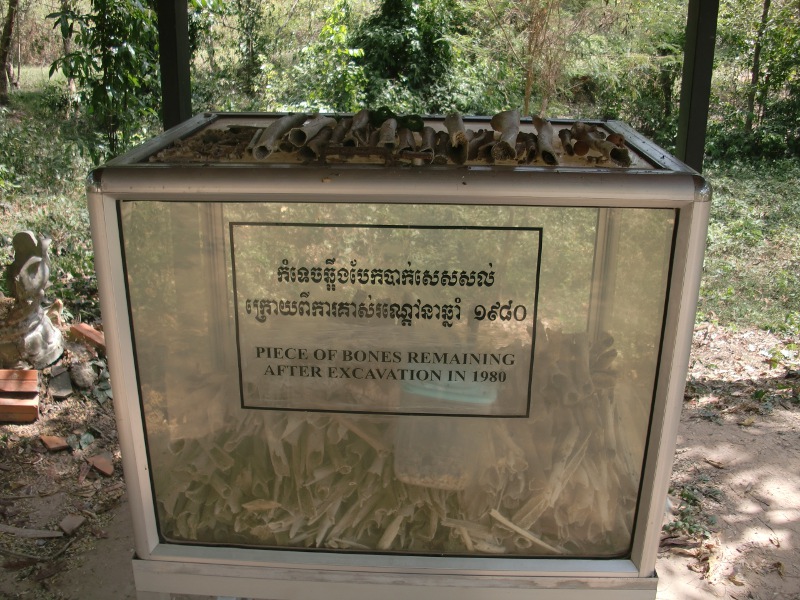
Bones of executed victims dug up soon after liberation.
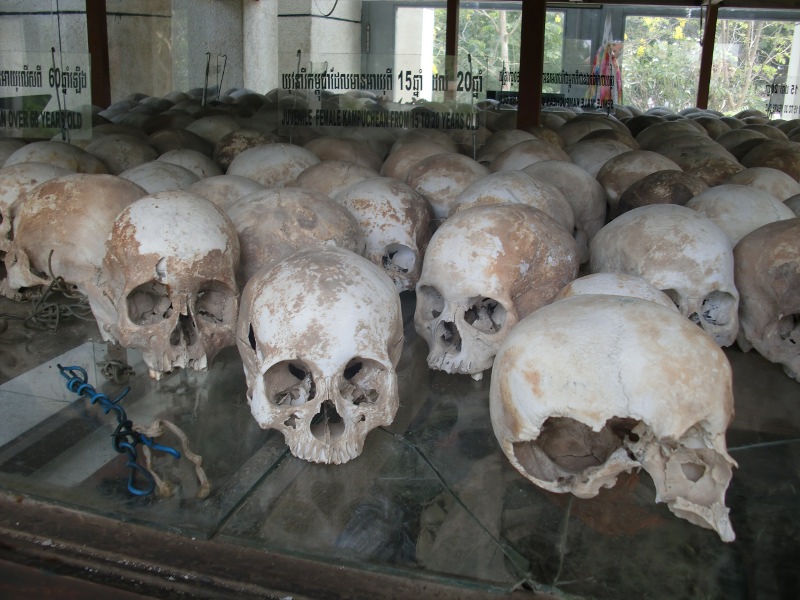
Preserved skulls of Khmer Rouge victims. The Buddhist stupa this is in has 17 levels of bone upon bone, all categorised, sorted, and preserved as a memorial.
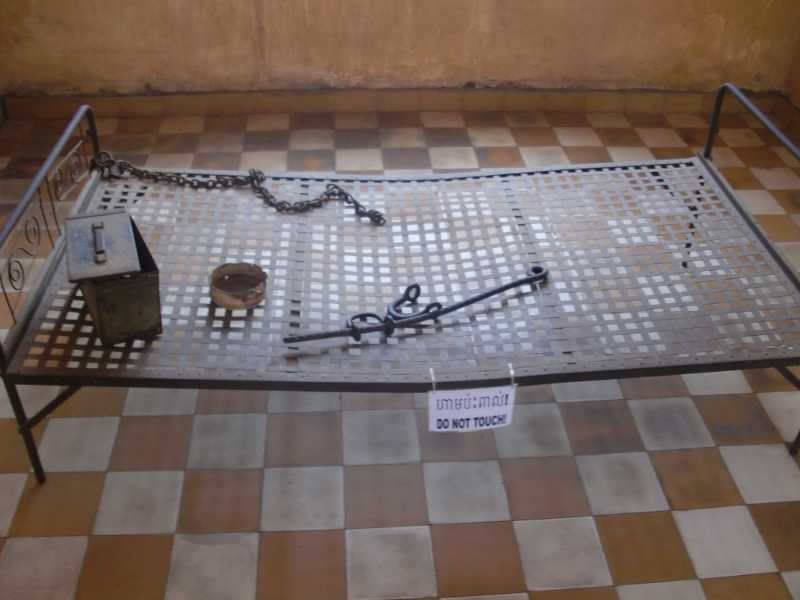
An example of one of the metal beds prisoners were chained to in Tuol Sleng Prison.
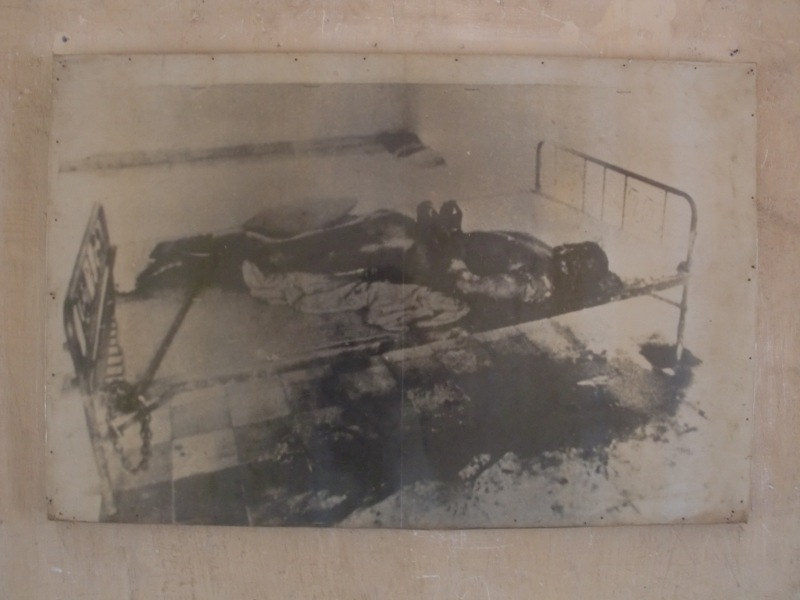
A photograph taken of a victim found dead in the prison upon liberation by the Vietnamese.
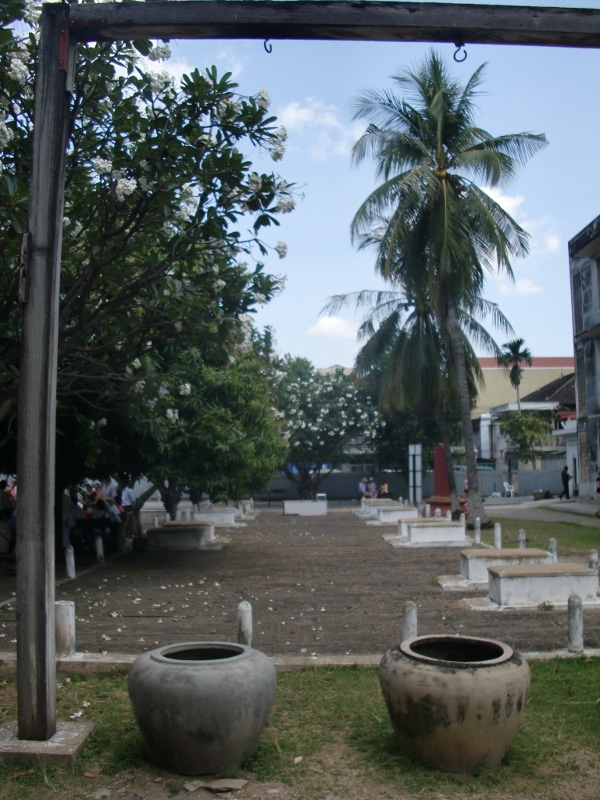
The gallows, not a place of execution but of torture; prisoners were hanged upside down and their heads dipped in a bucket of excrement.
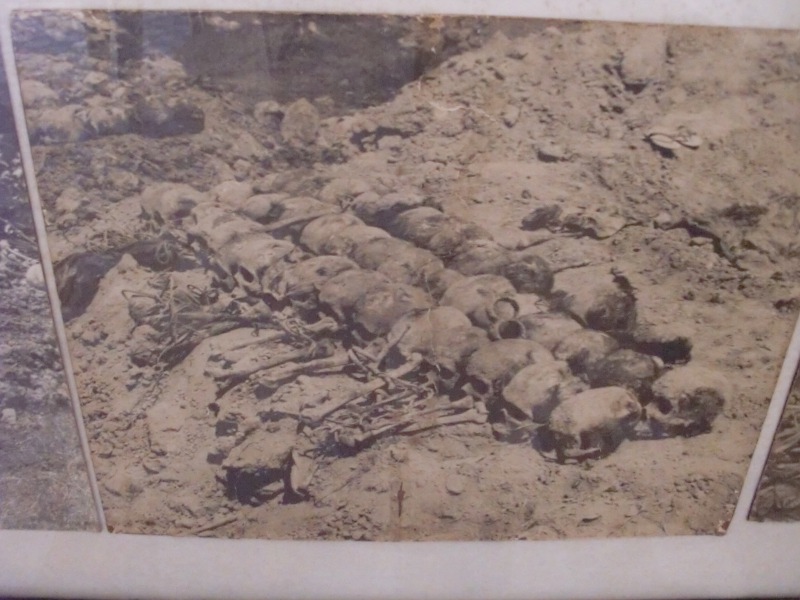
A row of skulls in situ at a Killing Field when the Vietnamese liberated.
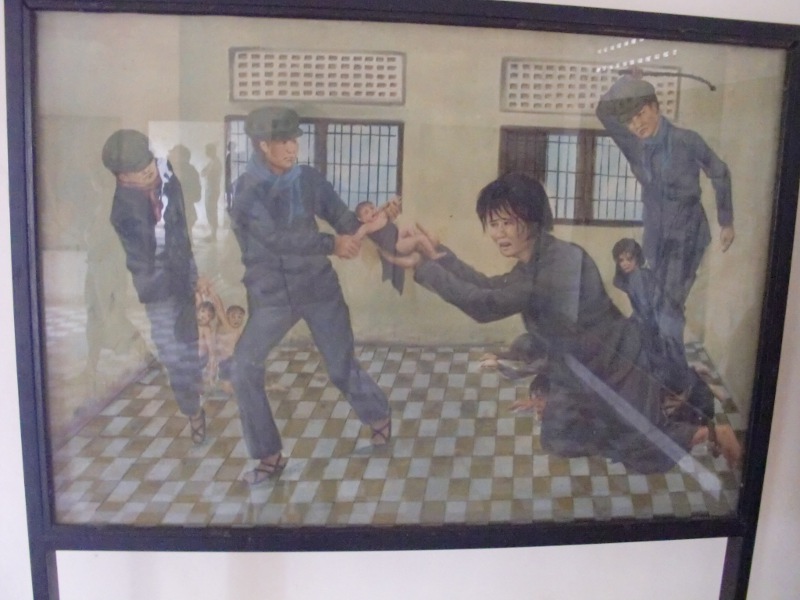
Painting done by one of the few survivors of Tuol Sleng of what he’d witnessed; this is a baby being forcibly taken away from its mother. Both likely to soon be dead.
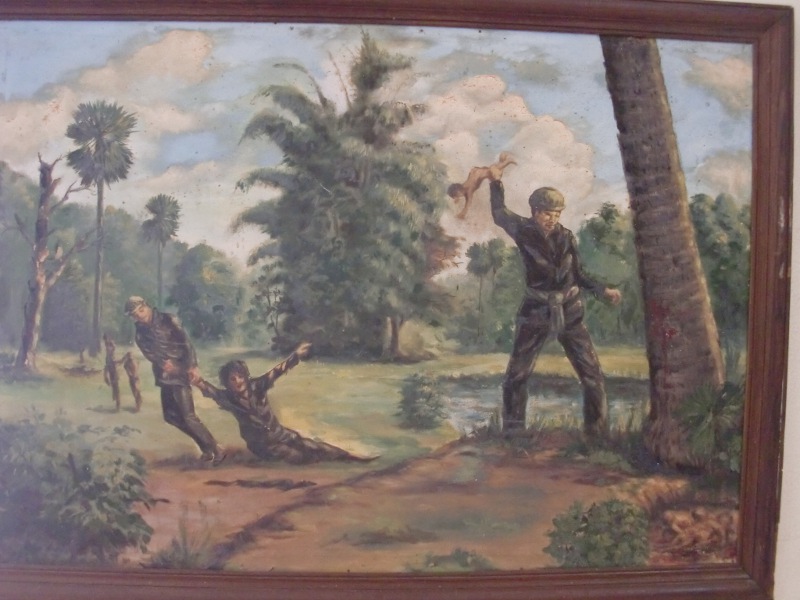
Painting done by one of the few survivors of Tuol Sleng of what he’d witnessed; this is a baby being thrown against the tree pictured earlier.
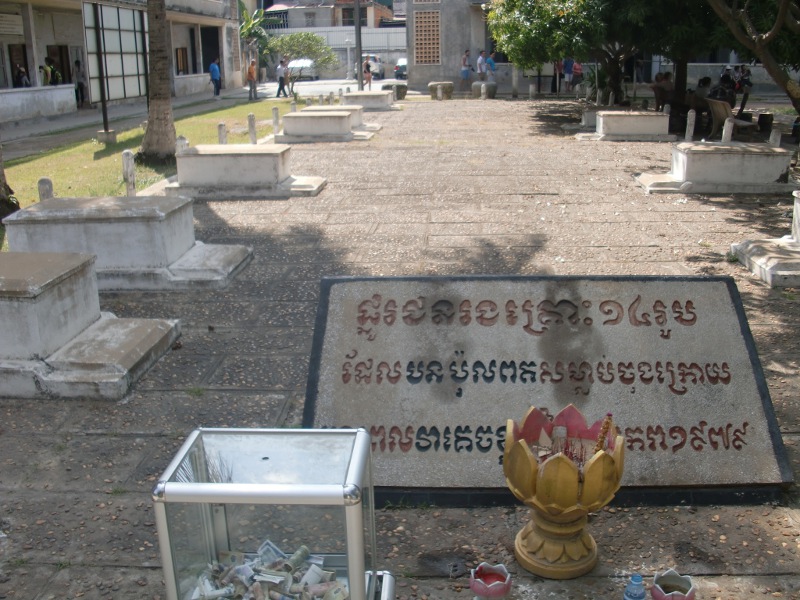
The graves of the last 14 people to be killed in Tuol Sleng, who were discovered by the Vietnamese.
Day 16: Monday 5 March (Part 2) –
I was born in Year Zero
I wasn’t originally going to come to Cambodia. My initial plan was to go into Laos and go North, and cross into Vietnam at Dien Bien Phu, and then hit Hanoi. But once I decided on going to Cambodia (at the time, “as well” as South Vietnam, ending in Ho Chi Minh City), there was only once place that was definitely on my list. I mean Angkor Wat is the mother of all temples, and the only reason most tourists ever go to Cambodia (unless your name is Paul Gadd, of course!), but I was even originally going to pass on the temples in order to go to Phnom Penh. Not because I fancied the city, but rather because of a little more recent history.
To be absolutely precise, I was born a few months *after* the Khmer Rouge victoriously entered Phnom Penh and took power on April 17 1975, but they designated 1975 as ‘Year Zero’, and, effectively, tried to restart history. I was too young to remember anything about the Khmer Rouge (although I have smatterings of memory beforehand, the first absolutely historic event I remember was the SAS storming the Iranian embassy in May 1980), but, whereas people who lived through the Nazis or Stalin are slowly dying out, the Khmer Rouge reign is still well within “living memory”.
It’s hard to express exactly what happened with sheer words, hence the pictures in the previous entry. The concept was actually pretty simple: a chap from Cambodia called Saloth Sar was educated in France, and while at University there he got influenced by the radical left (as you would in France in the 50s!). Upon a later trip to China, he was incredibly impressed with the concepts of the Cultural Revolution, and tried to imagine how that would work in his home country. When he visited the very rural East of Cambodia, with peasant farmers, he decided the ideal future for Cambodia was as a purely self-dependent, agrarian society, with no need for money, hierarchies, or education, as everybody would be fully employed working on the land for the benefit of the state.
Now, given a gradual long-lasting series of re-education plans, organised logistics, and the will of the people, he might well have done rather better. However, his simple plan was simply executed: upon finally gaining control of Cambodia, within *48 hours* he had closed all the hospitals, all the schools, all the monasteries, and evacuated all the cities, transporting *everyone* to work on the land. He declared this to be the start of a new Cambodia – ‘Democratic Kampuchea’ – and from here on, he declared that Year Zero had begun.
You might well want to examine just how bad this plan was actioned then. Take a bunch of city-dwellers who’d never handled so much as a hoe in their lives and get them to work on the land to produce excessive amounts of food, for effectively no wages and with little training. Added to this there was no treatment for disease except local remedies, and that the people already *in* the countryside didn’t much like or trust these ‘New People’ from coming in where they were, effectively, not wanted. In addition, working conditions were, uhm, ‘basic’ – work over 12 hours a day doing very physical work, with only a couple of bowls of gruel/rice-based watery stuff a day.
People were separated from their family. The Khmer Rouge theory was that *they* (the state, the party, the country) were the only family you needed. At first people were sent back to their ‘home’ villages, but over time people were moved about the country wherever the government deemed they were needed. Men were kept with other men, women with other women. Children were, more often than not, recruited to be the ‘soldiers’ (as the Khmer Rouge knew that children were much more easily ‘moulded’ to a certain viewpoint without asking the necessary questions). After the Khmer Rouge fell, there are millions of tales of families moving back across the country to try to find their loved ones, often to discover they weren’t going to be coming back at all.
And then of course there was the fear. Fear of being arrested, fear of being shot, for the smallest of offences. One woman was killed on the spot for being accused of stealing two plantains, which she’d claimed had been given to her by a guard. Who denied all knowledge, of course. Every weakness was eradicated. There was a regime of terror.
Some people didn’t even get that far. In the hours after taking power, the Khmer Rouge eradicated pretty much the entire administrative body that had preceded it. Anyone who had worked for the previous regime, anyone related to someone that had, even friends, were systematically killed. Then they purged on the elites and the intelligencia. Anyone who spoke a foreign language, anyone who had a degree education, anyone who wore glasses, anyone who had soft hands (a sign that they didn’t work on the land), was taken away and killed. No quarter given. Which is ironic as several of the leaders of the Khmer Rouge had, er, been educated to university level in France. Amazing how often dictatorships are hypocritical).
Overall, estimates of between 1 and 3 million people died in the 3 years, 8 months, and 20 days of the Khmer Rouge regime, either directly (by being killed) or indirectly (by dying of starvation, overwork, or disease). The population of Cambodia at the start was only about 7-8 million. So, at lowest estimates, 20% of the entire population died.
If it happened now, I can pretty much guarantee that everybody reading this will be dead within two days.
Why am I telling you all this? Because today I visited the two main sites of, how you might call, ‘memorial’ to the Khmer Rouge – the notorious Tuol Sleng prison and the Killing Fields of Choeung Ek. Both are detailed complexes that pull no punches about what they are.
I went to Choeung Ek first – it’s about 15km SW of the city and, at the time, would have been ‘quite a long way’ outside the city proper (these days it’s pretty much in the suburbs). Originally a Chinese burial ground (and there are still scattered remains of Chinese gravestones, mostly long since destroyed), it was turned into a very organised and processed site of mass execution. Prisoners were loaded onto trucks more-or-less at dusk from Tuol Sleng Prison and taken, bound and blindfolded, to the site. Mostly they were told they were being transferred to a ‘new house’ but is likely some of them were well resigned to their fate. There then followed a simple checklist of processing each prisoner individually (to make sure none had escaped), then getting them to kneel down while one of the guards hit them over the head with an implement originally used for farming, or in some cases, slit their throat with a palm tree branch. See, recycling and making use of the natural environment! No waste here!
Generally, the Khmer Rouge didn’t just kill one person, they killed the entire family. This included babes; their theory being ‘to get rid of the grass you have to get rid of the roots’ – leaving no-one behind who could take revenge. You didn’t have to have *done* anything to be arrested either, they just had to *think* something, or even just not like you. Party members were especially pounced on (to preserve the integrity of the revolution) – a bit like Stalin before them, the Central Committee of what they called ‘Angkar’ (‘The Organisation’ – a front for the Cambodian Communist Party) were somewhat paranoid – one of the mass graves at Choeung Ek was found to contain 166 headless bodies, all of whom were dressed in the uniform of the Khmer Rouge. It seems these were soldiers who were killed in a purge of Eastern Cambodia of ‘undesirable elements within the revolution’ – this included the head of the entire Eastern Zone, as it was believed he was in league with the Vietnamese). This made the Khmer Rouge reign rather hard for the average Cambodian to survive, unlike say, Nazi Germany, where as long as you were ethnically Northern European and kept your head down and said the right things, it was actually pretty easy to survive.
[Side note: This leads open to question the exact word that should be used to describe it. Genocide isn’t technically accurate since, although ethnic groups were targeted (mainly the Chinese and especially the Vietnamese), native ethnic groups within Cambodia itself seemed to do rather well out of the regime. In addition, people seem to have not been killed because they were *ethnically* foreign, more because they were *actually* foreign. Also, most people who were killed were ethnically Khmer – Auto-genocide has been used for this but it is an awkward term. It’s also not a War Crime since, regardless of the ongoing Cambodia-Vietnam conflicts of the late 70s, the deaths themselves did not take place under a state of war. One *could* theoretically use the term Holocaust as the word has been used to describe several major massacres over history, and simply means ‘whole (ie all of it) burnt’, but that word of course has specific connotations these days.]
[Side note 2: The other comparison to be made between Democratic Kampuchea and many other totalitarian dictatorships is the fact that, with regard to orders and processes, Angkar was top-heavy; that is, the leadership made orders and everyone followed. Stalin similarly was very good at this; if he wanted you dead, you died. Nazi Germany was pretty much the opposite; a *suggestion* from Hitler or Hess became a *recommendation* from the party which became an *order* from the middle-ranking officers/middle-management, who wanted things ‘done’ in order to further their career – in much the same way that many businesses (especially Call Centres) work these days, although obviously the Nazis were much more organised. Conversely, career development seemed to not be an option in Democratic Kampuchea; if you were young you were taken on as a soldier or a guard, otherwise you worked in the fields. Simple as.]
When the Vietnamese invaded and/or liberated (*) Cambodia in the 17 days following 25 December 1978 (don’t forget, the Khmer Rouge had emptied Phnom Penh and put everyone to work in the fields around the country. The Vietnamese came from the East, where they had a lot of underground support anyway, and the border’s only about 200km away, so they just simply walked in, pretty much!), the Khmer Rouge had not long fled from Choeung Ek, so everything there was as it was, with blood on the trees, bones everywhere, pieces of clothing torn and flapping in the breeze … must have been quite an appalling sight. Even today you can still come across the occasional piece of bone that has recently come to the surface. Most of the bones have been now properly handled according to Buddhist tradition, which, combined with preserving the memory, means that a Buddhist tower has been constructed in the site with 17 levels, each level containing bones of varying types and ages – the lower levels have the skulls whilst the higher levels have the other bones and bone fragments, all sorted by age, sex, and type.
(* depends who you ask. The Khmer people would say liberated. The USA, UK, Australia, Thailand, and China say ‘invaded’ which is why we gave diplomatic recognition for the Khmer Rouge for a further 10 years. Hey, who cares if they’re genocidal maniacs, they’re not communists. Well, not any more. Meh.)
So, Choeung Ek was where they killed people. Tuol Sleng was where they tortured people. Originally a 1960s-built High School (and it shows, it’s an ugly series of buildings!), the Khmer Rouge turned it into the most notorious of their prisons – S-21 (note that there were hundreds of both prisons and killing fields scattered across Cambodia; these however were the biggest and most important of each).
The overall structure has been preserved – three blocks of three levels each, built around a wide rectangular open area that’s now been ‘gardenified’ but presumably would originally have been the playground. One of the blocks still has the rooms set out the way they were found when the Vietnamese arrived – with bare metal-framed beds in large empty rooms – but there are photographs on the wall taken at the time of the (dead) victims they found therein. Another of the blocks was converted by the Khmer Rouge into narrow cramped cells, some wooden, some brick, and these have also been left in situ – complete with remains of metal chains used to lock prisoners in place. Other rooms now have exhibits and photographs of all the people known to have been processed here (the Khmer Rouge were, like most dictatorships, very anal about processing and leaving traceable records). In the past, some Cambodians have gone there and seen photographs of long-lost relatives.
Torture methods ranged from waterboarding to sleep deprivation, from isolation to removing fingernails and toenails. The day lasted for as long as necessary, and the guards were as terrified as the prisoners (for fear that they’d be next in line if they did something wrong). The idea was to get a confession out of the prisoner – it didn’t actually matter what for – so many people just said the first ludicrous thing they thought of (being in the pay of the CIA was quite a common one). Once the confession was signed, they were generally carted off to Choeung Ek, and anyone mentioned in the confession would then be ‘called in for questioning’.
Not many people survived Tuol Sleng. Over the entire history of the site, only about 200 people are believed to have emerged alive (out of around 17,000 people imprisoned there) – when the Vietnamese came, there were between 7 and 12 prisoners alive in the entire complex. Everyone else held there had been quickly tortured to death before the Khmer Rouge fled. Those that survived had done so because of their skills – a couple were painters, and one was an engineer so had fixed things in the prison. One of the painters was invited back not long afterwards and asked to paint scenes he’d seen, to show the world what had happened here. If you’re wondering why he agreed, it’s because everyone in that prison made a pact with each other to tell the world, no matter how heart-rendering it would be; they vowed that they would not die in silence or in vain.
There are some photographs also in the centre of the leaders of the Khmer Rouge. People over time have come along and scratched their faces off and written expletives in Khmer over the top of some of the photographs. What a difference from Anlong Veng where they still laud over Pol Pot’s grave. But then the Khmer Rouge were *really* hated here in Phnom Penh. Interestingly, when they marched in in April ’75, they were at first seen as ‘liberators’ themselves, from a US-dominated nepotistic clique, and the people hoped the Khmer Rouge arrival would signal an end to the bloody civil strife and the bombing campaigns that had been ongoing for a number of years. That feeling lasted two days. When the Vietnamese came in ’79, there was no-one left to celebrate their arrival. Imagine a Scottish or (heaven forbid) a French tank driving up a completely empty Oxford Street in London, because everyone had been moved away to work on the fields in Norfolk. Eerie.
<Bathos>
And then I had a crepe/pancake with chocolate sauce, and a pineapple smoothie.
</Bathos>
I also managed to lose my tuk-tuk driver at Choeung Ek. I was slightly longer in there than anticipated (they had a personal audio guide to listen to as you walked round, so I listened to it all, including the story sections; they also had a short movie to watch, so I did), so when I came out he was nowhere to be seen. After looking around for about 10 mins I decided to have some food at a nearby food stall/court. He still wasn’t there when I came out but he saw me very shortly afterwards. Apparently he’d got bored and gone to the same food place but we hadn’t seen each other! (I knew he must still have been there as I hadn’t paid him yet!).
I also saw a small crash between two motorbikes. Nothing serious, but it was at the road junction pictured yesterday just outside my guesthouse. Something to note about Cambodian driving; they drive on the right. On a two-lane road, the middle lane is used for overtaking. Yes, I know what you’re thinking. But no-one seems to have told the Cambodians … !!
Day 17: Tuesday 6 March –
Happy Day
Today was a normal day in every way, with no depressive museums or sights. Almost boring in comparison, actually!
Ignoring Singapore (damn these early flights!), today is effectively my last full day in SE Asia, so it’s interesting to reflect on the symmetry here: I started in Laos with two full days in the capital (Vientiane), then a stay in the second city (Luang Prabang), then a short stay in a small town (Champasak) … then in Cambodia I did pretty much the exact reverse : short stay in small town (Anlong Veng), longer stay in the second city (Siem Reap), followed by two full days in the capital (Phnom Penh). And because I had nothing specific I wanted to see, like on Vientiane’s second day, I went for a walk around the place.
Phnom Penh is quite an easy city to walk around – or would be if the pavements weren’t clogged up with parked motorbikes and trucks. Everything’s on a grid pattern (very Americanised) and all the roads have two names – a ‘proper name’ like ‘Preah Vihear Street’, and a ‘numerical name’ like ’92nd Street’. Even numbered streets go East/West and numbering starts in the North, and Odd numbered streets go North/South and numbering starts by the Riverside in the East, and heads West. Most roads are straight, so it’s very much similar to the ‘block’ system in the US. However, this grid pattern was laid out by the French!
Even though it was morning (c.9am), it was already pretty warm (recent temperatures in Phnom Penh have been around 34 degrees C). I started out by walking North, towards Wat Phnom – ‘the temple on the hill’. Now, apart from the area around Prasat Preah Vihear and the Thai border, and the hill I clambered up at Kbal Spean, pretty much everything I’ve seen in Cambodia has been flat. On the journey from Siem Reap to Phnom Penh, I don’t think I saw any hills at all. This explains why Cambodia is great for bicycles and, to an extent, cheap motorbikes. It also explains why a 27m hill with a temple on top is such a popular tourist site …
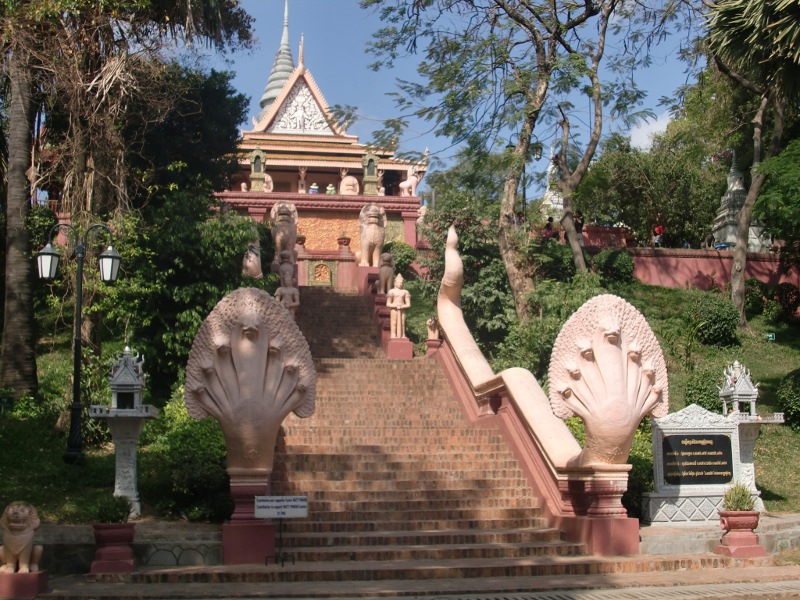
Virtually the only set of steps in Phnom Penh that aren’t in a building.
There’s actually apparently a whole host of touristy stuff at Wat Phnom, including elephant rides, but it’s built on a huge roundabout in the road network, and I must have come at it from the wrong side, cos I didn’t see anything much! It’s used as the local ‘please Buddha grant me luck in _____’ site, so incense and decoration is abound.
I then went further North, where few tourists venture; had a quick look at the Japanese Friendship Bridge (blown up in 1975, rebuilt 1993, guess who supplied the cash!) but couldn’t get a good view. I did get a better view at the historically significant but incredibly ugly French Embassy (where people fled the incoming Khmer Rouge only to be told by them ‘We don’t care about diplomatic privileges – get out or we’ll kill you’. The French reaction is not recorded, but presumably they weren’t up for a fight. Quelle Surprise!), before heading back towards the city centre.
After passing the intact but non-functional main railway station (closed presumably during the Khmer Rouge period – although they were using the rail network to move citizens around the country – but for some reason not reopened by the Vietnamese), I made my way to the slightly manic Psar Thmei, the Central Market. It’s huge (apparently one of the 10 largest domes in the world – one of those statistics where there is a lot of debate, no doubt!), and filled with stalls offering pretty much anything you want. Under the dome are the jewellery stalls, but much of the market is devoted to usual market tat – silk, toiletries, fresh meat, etc. The edge of the market is lined with the restaurant stalls: today I had squid. And rather a lot of rambutans, because I didn’t have anything smaller than a $1 note.
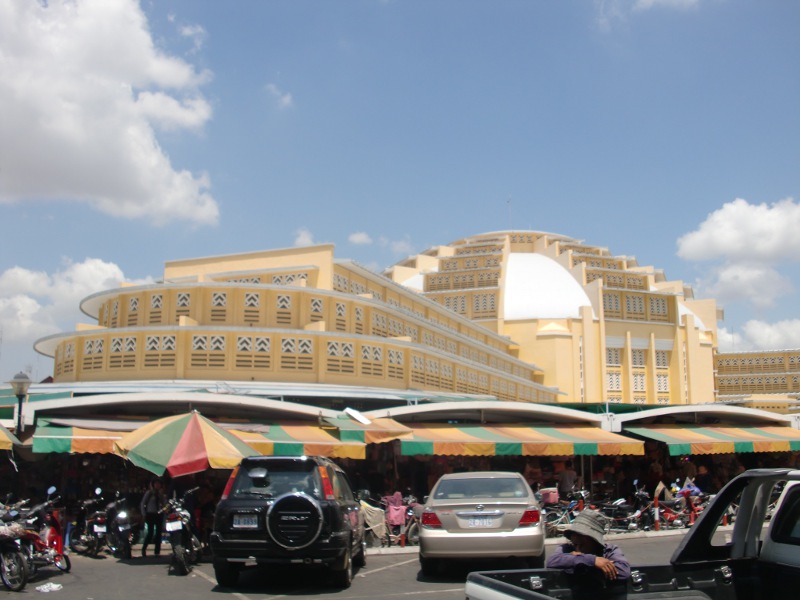
It actually looks slightly weirder than just a ‘dome’. In any case, it’s distinctive.
Suitably refreshed, I headed onwards, walking through streets of shops, until I realised that a) it was just after midday, b) the main site I was headed to didn’t open till 2pm, and c) I was three blocks from my hotel. So I had an hour and a bit of aircon relaxation!
Midday evidently isn’t the peak of the heat (although interestingly it’s more-or-less the peak of the daylight; dawn coming a little before 6am and darkness falling not long after 6pm), so when I headed out again at 1.30pm it was *hot*. But, still ignoring tuk-tuk drivers who thought I was mad (either that or they were laughing at my hat – something which I *know* people are doing, because they point directly at it when passing and doing so. Assume it’s because it looks Vietnamese and is being worn by a pasty white man. That’s white as in factor-50-sunblock white. Which, because it’s childrens’ sunblock, is actually pale blue. And since it doesn’t rub into my face particularly well, means I generally look like a pasty blue man. Hmmm, more ridicule.), I walked South towards the Independence Monument and the (somewhat ‘forced’, given their recent history) Cambodia-Vietnam Friendship Monument. The former looks like a Buddhist ‘stupa’, the latter, with the soldiers and the mother holding a baby, looks somewhat ‘Communist Ideological’.
Thence to the main event: the Royal Palace, containing The Silver Pagoda. It’s a relatively large compound behind large walls that serves as the main residence of the King of Cambodia. Yep, Cambodia has a monarchy – probably one of the few Communist states to have retained its royalty. The current King seems to stay out of politics and serves more as a kind of ‘figurehead’. The previous King, however … King Norodom Sihanouk (after whom one of the main roads in Phnom Penh is named) was crowned in 1941, abdicated in 1955 to take up a career in politics, dominated government until he was overthrown in 1970 (in part because Parliament believed he was spending too much time making films (!) rather than running the country), came back in 1975 as Head Of State under the Khmer Rouge (!! – he did a deal with them to get back into power), overthrown *again* in ’76/’77 when they got bored of him, came *back* in 1993 as King, and finally abdicated *again* in 2004, citing ‘old age’. His political party (Funcinpec) in the 80s and 90s was the official opposition to the communists and consisted of royalists, neutrals, and the remnants of the Khmer Rouge. It’s now disintegrating and a new political party of *liberals* (the Sam Rainsy Party) is now the second biggest in Cambodian Politics.
Anyway. Today’s History lesson over!
As befits a Royal residence, the Palace is both huge in area and very picturesque. However, also as befits a Royal residence, most of it is off-limits to tourists. But the *outside* of the pagodas and wats are very pretty … the Throne Room exceptionally so (it in itself is extremely large). The one building that is open to the public has a number of things on display from a royal wedding, and, creepily, seven life-sized mannequins of who I presume to be the King’s daughter, all dressed in different coloured outfits, one for each day of the week (literally! Saturday is Violet, Monday’s yellow). But in a ‘but wait, there’s more’ moment, a small passageway off to the South takes you into a completely different half, with stupas, epic murals, shrines to dead Kings, and The Silver Pagoda.
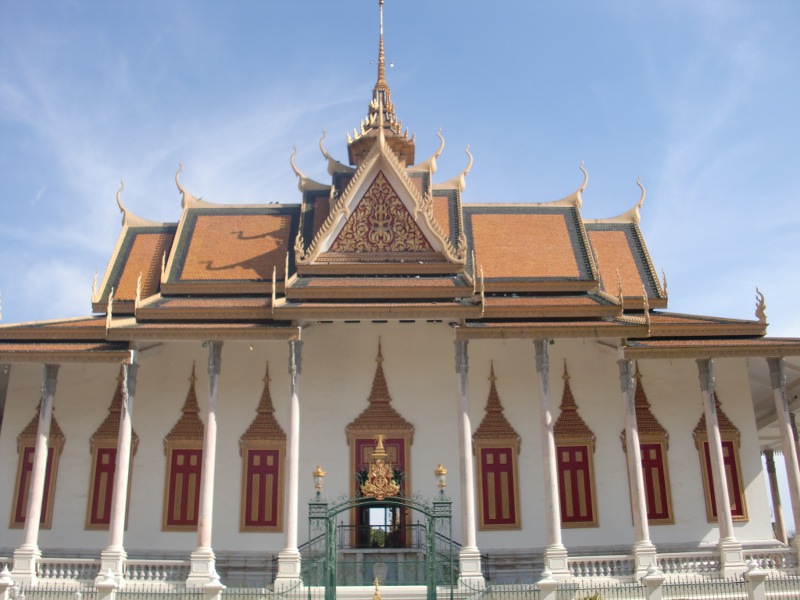
This is what the fuss is about. Yeh …
I’m hyping this up a bit much; the Silver Pagoda’s certainly an impressive building but it’s basically a large Buddhist shrine with some museum exhibits around the side. And you can’t take photos inside it. But it’s cool nevertheless!
Had something to eat at a dodgy cafe on the waterfront – the “Happy Herb’s Pizza”. On my last night in Siem Reap I did pass a chap in the town centre who wondered if I wanted any marijuana – when I said no, he then promptly asked me if I wanted cocaine or heroin. In parts of Laos (specifically Vang Vieng and Si Phan Don) you can get your meals normal or ‘happy’, where ‘happy’ denotes ‘herbs of a different flavour’. So similarly here: you can get pizza toppings normal or ‘happy’. I had the Fish Amok – I didn’t come to SE Asia to eat pizza, no matter what the toppings! FYI it’s next door to the ‘Happy Pizza Pink Elephant Pub’. The mind does not, unfortunately, boggle.
Had a slow wander back to the hotel before heading off again to have some stodge-building rice, as my digestive system seems a bit weakened today – I’m blaming the chillies in both the dip with the squid and in the Amok. Sitting outside a nearby cafe eating my meal, three young Americans passed, dressed for a beach holiday: the two guys were in vests, long shorts, and sandals, the girl in a vest, very short shorts, and barefoot. They wanted pizza to take away, and were slightly impatient and somewhat blaze about the cafe. I thought to myself ‘Is this what it’s come to? Was it worth winning the Vietnam War?’.
[They didn’t get their pizza in the end, either, despite coming back three times for it and waiting about 20 minutes. No idea why. They should have had the chicken fried rice instead! :p]
Day 18: Wednesday 7 March –
English Summer Already?
Today was unusual; I had breakfast. Well, noodle soup anyway; I had time to kill before my Tuk-Tuk driver (the once who’d taken me places on Monday) would arrive and whisk me off to the airport. Plus I figured that if I ate something reasonably substantial now, I wouldn’t have to eat too much later when I was in Singapore and prices would skyrocket.
Reasonably interesting journey to the airport – maniacal drivers all around, and we got stopped by the police, primarily because “they needed some money”, as my driver tactfully put it. This is apparently reasonably common in Cambodia.
Phnom Penh International Airport is, I dunno, maybe the size of East Midlands airport? It’s not a huge place, but equally it’s not a runway and a portakabin for a terminal building. But one thing it is, is quiet. Non-passengers aren’t even allowed into the terminal building, and as far as I could tell there were only four listed departures during the whole of time I was in there – Kuala Lumpur, Singapore, Taipei, and, not long before I was due to board, Yangon appeared. Security was a bit lax (I went through security *with a bottle of water* shock!), and while there’s nothing landside, there’s not a lot airside either – a couple of shops and a couple of restaurants. The bookshop sold a whole gaggle of phrasebooks … except Khmer. So even in the *airport* I wouldn’t have been able to buy a phrasebook to help me round!
Flight took just under 2 hours. Operated by Jetstar, a low-cost subsid of Qantas; yes, the majority of the flight crew did indeed speak with an Australian accent! This was slightly surreal. It being a budget airline, of course you’d had to pay for everything, but my taste was sated by the remaining few rambutans I’d bought yesterday.
I got stopped at Customs, who were x-raying everyone’s baggage. They found a knife in mine; this confused me, and confused them when I told them I hadn’t got one. After searching through the bag, and knocking off everything possible off the list (apart from clothes, I don’t carry much!), the offending item was discovered and analysed. I’d forgotten I’d bought that, and much less where I’d put it, but in Siem Reap I’d bought a little gift for someone back home – long, thin, metallic, with a point on the end. But no, it’s not a knife. They were happy. 🙂
Singapore airport is very big. But it felt very … ‘quiet’, ‘serene’; there didn’t feel like there were many people around (even though there quite blatantly were), there was just something weird about the ambiance and atmosphere that was somewhat, I dunno, ‘calming’? It all feels like marble interiors and wide open spaces; not quite ‘cathedral’-like but certainly those kinds of effects.
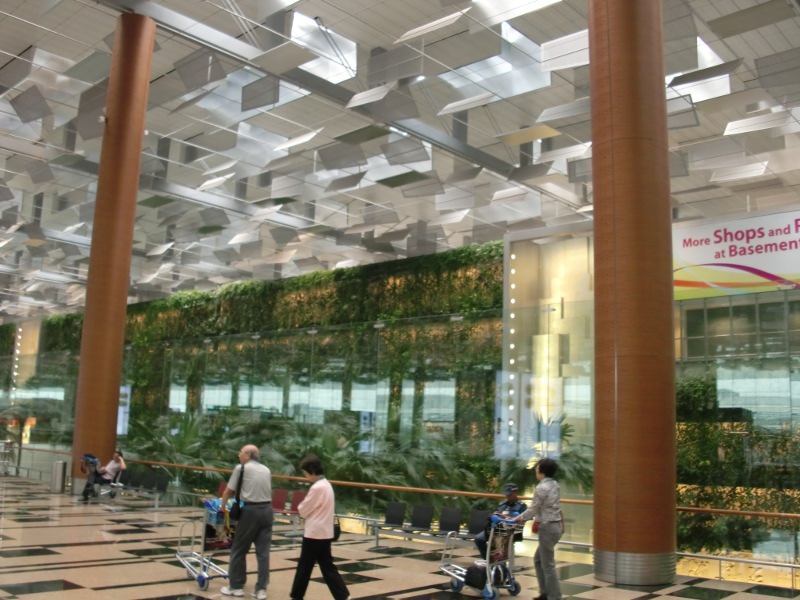
Inside Singapore Changi Airport. It was nice, but didn’t feel like an airport.
Journey to my hotel was efficient – the walk from the local metro stop was longer than it felt on the map though. The weather was grey, overcast, about 28 degrees C, and humid as hell. Pretty much everything’s in English, they have a nice selection of single- and double-decker buses, the road names I passed included ‘Lavender Street’ and ‘Hamilton Road’ … yeh, and English prices too. See, I always had the impression that Singapore would be expensive. From what little I’ve seen, while it’s obviously more expensive than Laos and Cambodia, it’s probably not much different to back in the UK – maybe a little cheaper here even. It’s just that relativity I have to get used to.
Had a brief problem checking in to the hotel; when I book ahead I tend to use Agoda – most of the time the cross-reference of booking ID is fine, but this time the chap who made the booking on my behalf seems to have put down *his* name rather than mine when the booking was made! But this was quickly sorted, and I enjoyed the aircon in the reception area while I waited.
Went for a little walk around the area of my hotel – it’s not in the centre of Singapore, rather on the edge of an area called ‘Little India’. Obviously all the restaurants and temples around here are, hang on, Chinese?! A little walk deeper into the heart of the district however brought me to proper Hindu temples and a series of off-street food stalls where I got tempted in for dinner. Cheese Naan, rice, curry sauce, and tandoori chicken, for 8S$ (about £4). And I was the only westerner in there – *everybody* else (and there were four stalls, the seating area was pretty full!) was a) male, and b) Indian. On my way there I did pass something I thought was odd – a fast-food-looking Vegetarian Indian restaurant! It *looked* for all the world like a McDonalds, in terms of store layout, similar seating, etc, but it sold various kinds of Indian veggie fayre! Very strange …
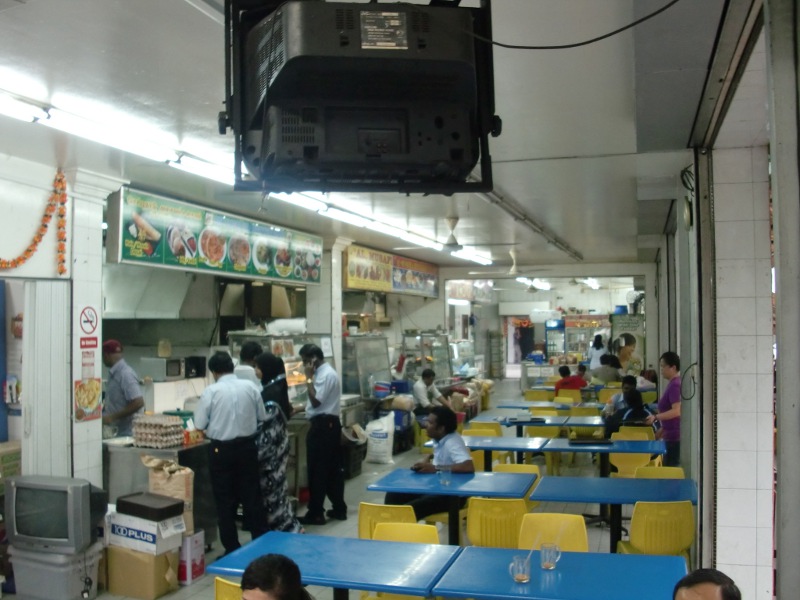
There was more seating outside, to the right, which was full.
As I wandered back to the hotel, something happened that I hadn’t seen since Kuala Lumpur, more than two weeks ago. Drops of strange wet stuff started to fall from the sky! Have an early start tomorrow – my flight’s about 9.30am so I’ll probably rise about 6am; also note that despite going mostly South and a bit West, Singapore is, like Malaysia, an hour *ahead* of Cambodia/Laos, so I’m now GMT+8, for a night, which is going to confuse me a bit!
Day 19: Thursday 8 March –
Yes, but it’s *only* a Ferrari
Went to bed early last night, after battling with the slowest and weakest Wi-Fi signal in the world – even in the designated Wi-Fi seats I couldn’t get a signal, and in the reception area the signal was pretty poor. Apart from that the hotel was pretty fine. Got up 5.45am, due to a relatively early flight from Singapore.
Journey to the airport was fine with no hassles; checked-in very swiftly, and then meandered through Singapore airport seeking out breakfast. Ended up with peanut butter toast and some water as being, surprisingly, the best option.
Long flight, got a bit bored after a while, Yet again, was listening to the music; this time I went from 1979 to 1982. For those of you who think I’m an unemotional soul, this may have been confirmed when I didn’t even shed a tear during ‘Bright Eyes’ by Art Garfunkel, although we were taking off at the time … I also passed my time in another film-watching shock; this time it was an 80s film that I really should have watched years ago – Tron – and which one of my friends online has had in her mindspace for a while!
Getting through Dubai immigration was a bit slow – was in the queue for about 40-45 minutes. This is more because they process each person very slowly and precisely. Or I think they should do – they seemed to speed up when they were processing the 9 or 10 young Japanese culture exchange students in front of me, so maybe they got slightly bored?
Joanne, my step-cousin, met me at the airport and we sped over to her place by taxi. It’s a bit ‘out the way’ in an area that’s not signposted and which involves a rather strange route ’round the houses’ (in fact half the houses haven’t been built yet!), and not many taxi drivers know where it is. Sounds a bit like my house really, except for the ‘new construction’ bit …
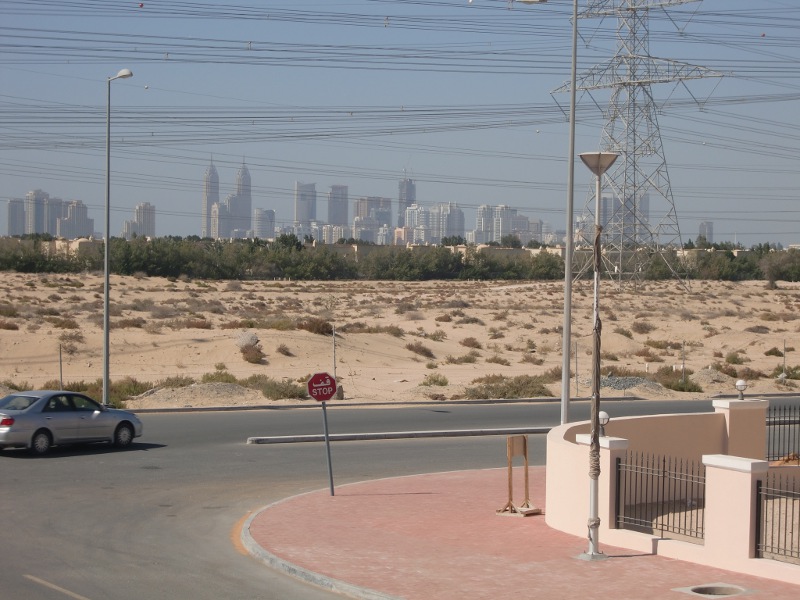
Told you there was an ‘unfinished’ look! Still quite nice though!
Most of the rest of the day was spent browsing – she took me to the large Mall of the Emirates, just for the craic; Starbucks was entered (Neither Laos nor Cambodia have Western Chains. Cambodia has fake western chains; there is for example a KFC in Phnom Penh but I’m not convinced as to its authenticity. Cambodia, until recently, had no copyright legislation …), and things like the fish tank and the ice-hockey rink were noted. We also passed the Dubai ski slope. Which means, of course, that a city in the middle of the desert has better Winter Sport facilities than central England (Tamworth, I’m looking at you and your fake snow dome thing!).
There’s also a blase-ness about the cars – ‘oh it’s only another Lamborghini, boring’. Supercar buffs would have had an orgasm in the valet parking outside the mall. I get my kicks elsewhere … although what *was* a bit odd is that 90% of the cars were either black or white, even the Ferraris. And in any case it makes a change to be in a place which isn’t dominated by Motorbikes. Although the driving’s just as bad – just faster!
The Dubai metro is swift, clean, and efficient … and even the fact that Joanne a) used the wrong ticket for herself, and b) bought *me* the wrong ticket, didn’t dampen the fun! Lol. Anyhoo, we got back home, chatted late into the evening, and then went to bed.
Day 20: Friday 9 March –
Glorified Shopping Cent…Oh, Wait!
Woke up around 12.30pm. This was unintentional, and meant that I’d been asleep for about 12 and a half hours and had accidentally reverted to UK time rather than Dubai time. Fortunately today was Friday and therefore nothing was actually *open* until around 2pm …
We ended up setting off a little after 2pm-ish, in fact, and first headed for the Mall of the Emirates for breakfast/lunch. After having some throwaway fast food (including, for me, a peanut butter milkshake – yum!), we got the metro over to the old part of the city. My task for Joanne had been to prove to me that Dubai was more than just a glorified air-conditioned shopping centre, so she took me to the part of town where it all began, basically.
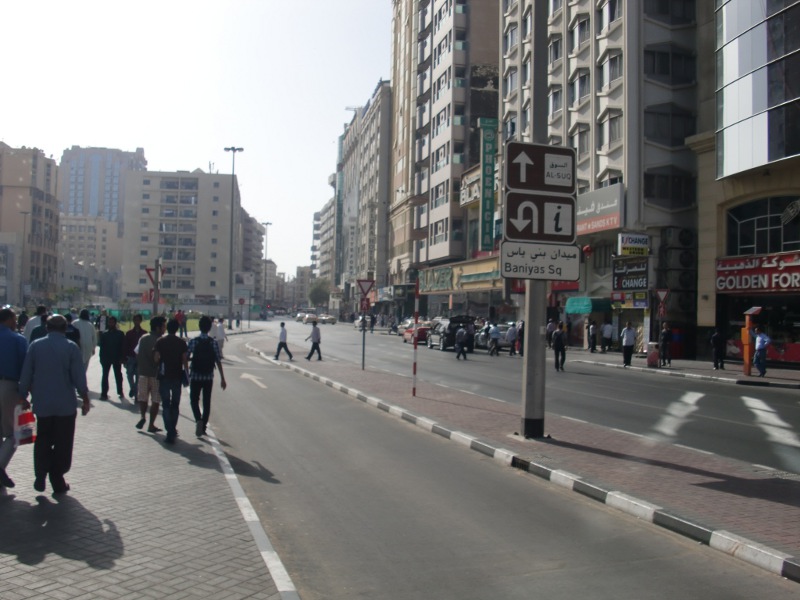
Baniyas Square, and not a skyscraper in sight!
We started in a place called Baniyas Square, and had a walk through a few of the ‘souks’, or market areas. As in a typical Arabic town, these are full of narrow alleys with stalls and shops, each offering their wares in typical ‘come in, come in’ friendly-style banter. Although we passed through the spice, gold, and textile souks, most of the stallholders were more interested in trying to offload ‘sunglasses, watches, handbags, pashminas’ (in that order). The nice thing about going round with Joanne though is that when she says ‘I live here; I’m not a tourist’ they all tend to back off … Plus she went there specifically with three of those items visible on her person. Not that that helped … !
We then took a short boat ride across ‘The Creek’; the natural channel of water around which Dubai built up. It’s still the nerve-centre for the trading aspect of Dubai’s finances, so you can see scores of ships here – mainly small Dhows filled with consumer goods (eg flat-screen televisions) bound from or to places like India. How they don’t sink from the weight (bearing in mind they’re mostly made from wood) is a feat of engineering in itself!
On the other side of The Creek, we had a bit more of a wander, past a couple of pretty Mosques, until we reached the Dubai Museum – quite an interesting place, especially for the 3 Dirham entry fee (about 60p). It gave details about the history and geography of the Dubai area – although in quite a simple way (child-friendly, one might say), it was informative; even Joanne learned something (like why the sand further out into the desert was red; because of the iron ore in the mountains). The museum itself is set out in a building that looks like an old desert fort of the kind the Foreign Legion might inhabit.
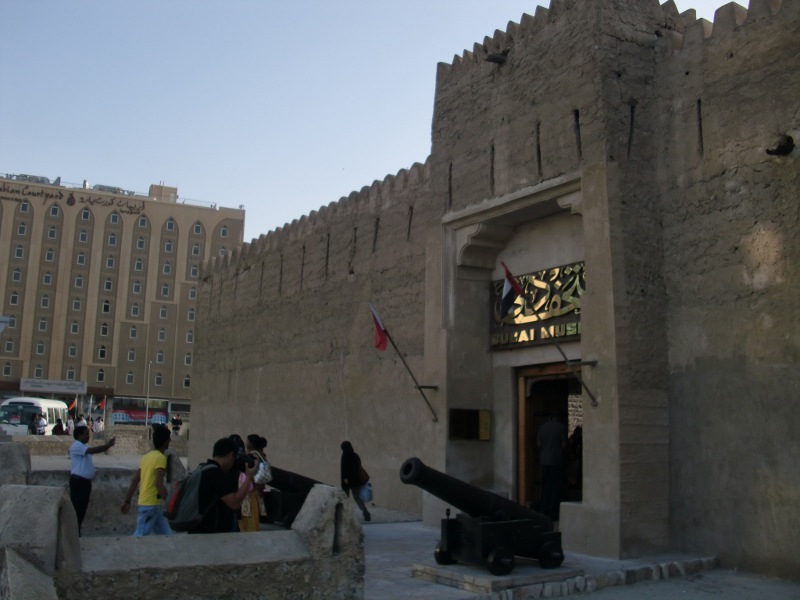
See, it’s even got cannons!
From there we headed back across the river and had some simple food at one of the waterfront cafes – very nice but I couldn’t finish mine cos I wasn’t actually that hungry. We did get a large (proper traditional beer pint glass!) drink of fruit smoothie/juice type thing too which was really nice.
By now it was getting dark (the last sunset of my holiday! Booo!); we headed back along the metro – mmm city lights -, and, after a quick wander around the mall again, we headed back in the car to nearer Joanne’s house. We stopped off in a Starbucks for a drink and a long stimulating intellectual discussion before going home.
Days 21 & 22: Saturday 10 & Sunday 11 March –
Tramadol
Got up around 9am, thus moving myself inconveniently back onto Dubai time rather than staying reasonably close to UK time. But I guess this was necessary; despite my flight not being until 2.30pm, it at least gave me a chance for a last look around Dubai.
Joanne took me for a little drive in the morning, down the main streets of Dubai but also along the shoreline. Not much traffic, except by the coast, which was actually full of tourists. Damn I hate tourists – they get in the way all the time! (Though individual tourists aren’t as bad as tour *parties* who really do get in the way, walk too slow, and stop without warning. Though they *do* drag touts away from you making your journey a little less hasslesome!).
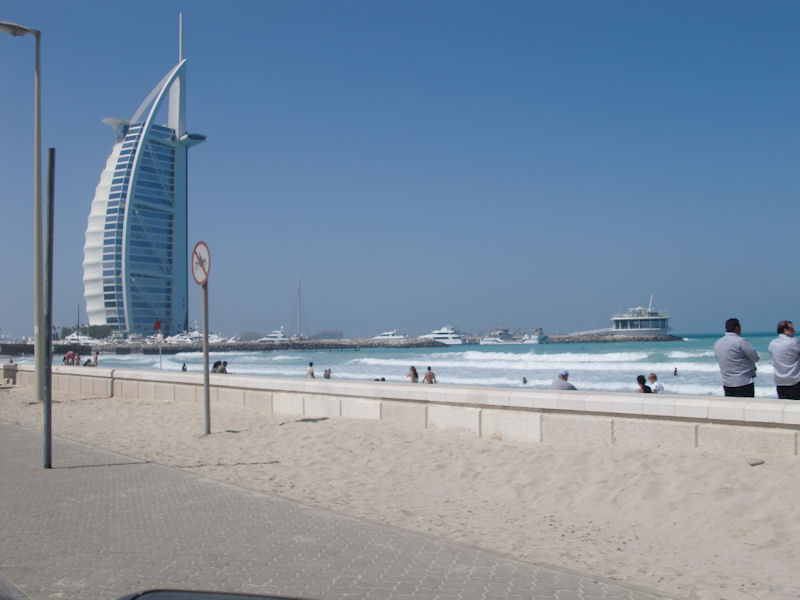
Dubai’s seafront. And this is one of the less exclusive areas …
A couple of the roads we drove along are used in the evenings by the local youngsters, who speed around with bass blaring to try to impress the ladies. Of course, this being Dubai, they’re not in Vauxhall Corsas. Also, the concept of ‘pimp my ride’ doesn’t really exist – well it’s kind of hard to ‘pimp up’ a Lamborghini … As a side note, all the malls have the option of valet parking. One of the more embarrassing things to do therefore in Dubai is to make use of these facilities … when you drive a Ford Focus. Snort.
It’s not all skyscrapers, beaches, and fast cars of course – there are parklands which (in typical Dubai style) are pretty huge – one of which has a running track around it of several km. And yes, with a decent enough vehicle, you *can* go dune-bashing. Although not after a big meal. Probably a *good* thing that alcohol is regulated here :p
We got to the airport in pretty good time so, after bidding Joanne a fond farewell, I had a couple of hours to kill. This is where the holiday ends. Not a lot happened in the airport (after some peanut butter toast, I wandered around aimlessly for a bit to kill time), but that was considerably more than happened in the aeroplane. The journey back was just under 8 hours (so longer than the way out; ‘head winds’ apparently) – I haven’t felt quite so stir crazy in a long time! It meant I landed into Manchester airport about 7.30pm rather than the 6.30pm I was expecting. Gaah, angsty!
Manchester Airport also saw the demise of my little pink notebook computer. I had my daypack on the coat-hook on the inside of a toilet cubicle door, and pulled on it a little too hard. The bag slipped, fell on the floor, and must have damaged the connections to the hard drive inside the computer as when I turned it on it said ‘Operating System Not Found’. Careless.
Caught a train to Manchester and then to Sheffield (5-min connection in Piccadilly, not bad) meant I reached Sheffield not long after 9pm. Had two minor problems with my debit card (in the station, the ticket guy just swiped it and got me to sign, and at Sheffield I had to try twice in the ATM). The money exchange office in the airport wanted to give me £19 for my 160 Dirhams (bear in mind there’s about 6 Dirhams to the £!) so I told him where to go! Got to my friend Debbie’s house, had pizza, and a reasonably early night.
Got up 10am-ish, and headed into Sheffield City Centre. Put my Blackberry in to Vodafone to get repaired (they’ll have to send it off, as they don’t sell that model of phone any more and they no longer have any batteries for it) – they gave me a very old Samsung as a courtesy phone that my *other* phone, a K750i Eriksson, is actually better!, picked up some fruit and soup from M&S, then got the train down to Alfreton (well, Chesterfield: rail replacement coach the rest of the way). Caught taxi back to my house.
Nothing had changed. My house felt cold, and empty. The whole journey back home in England felt ‘dead’; well, quiet, dull, as if there was no-one else around, empty, unexciting yes, but more … as if the whole country was on Tramadol – not much noise, not much chatter, not many people, as if everywhere was asleep. Very odd.
Next stop, Belgium!